 Hastings District
Council
Hastings District
Council
Civic Administration Building
Lyndon Road East, Hastings
Phone: (06) 871
5000
Fax:
(06) 871 5100
WWW.hastingsdc.govt.nz
Open
A G E N D A
Council MEETING
|
Meeting Date:
|
Thursday,
27 June 2019
|
|
Time:
|
10.30am
|
|
Venue:
|
Council
Chamber
Ground Floor
Civic
Administration Building
Lyndon Road
East
Hastings
|
|
Council Members
|
Chair: Mayor Hazlehurst
Councillors Barber, Dixon, Harvey, Heaps,
Kerr, Lawson, Lyons, Nixon, O’Keefe, Poulain, Redstone, Schollum,
Travers and Watkins
|
|
Officer
Responsible
|
Chief Executive – Mr N Bickle
|
|
Council
Secretary
|
Mrs C Hunt (Extn 5634)
|
HASTINGS DISTRICT COUNCIL
COUNCIL MEETING
Thursday, 27 June 2019
|
VENUE:
|
Council Chamber
Ground Floor
Civic Administration Building
Lyndon Road East
Hastings
|
|
TIME:
|
10.30am
|
|
A G E N D A
|
1. Prayer
2. Apologies
& Leave of Absence
At the close of the agenda no
apologies had been received.
Leave of Absence had previously
been granted to Councillor Lyons
3. Seal
Register
4. Conflict
of Interest
Members need to be vigilant to stand
aside from decision-making when a conflict arises between their role as a
Member of the Council and any private or other external interest they might
have. This note is provided as a reminder to Members to scan the agenda
and assess their own private interests and identify where they may have a
pecuniary or other conflict of interest, or where there may be perceptions of
conflict of interest.
If a Member feels they do
have a conflict of interest, they should publicly declare that at the start of
the relevant item of business and withdraw from participating in the
meeting. If a Member thinks they may have a conflict of interest,
they can seek advice from the General Counsel or the Democratic Support Manager
(preferably before the meeting).
It is noted that while Members can
seek advice and discuss these matters, the final decision as to whether a
conflict exists rests with the member.
5. Confirmation
of Minutes
Minutes of the
Council Meeting held Thursday, 30 May 2019 (Keirunga Garden Tree Management
Plan).
(Previously circulated)
Minutes of the
Council Meeting held Tuesday 4 June 2019, including minutes while the public
were excluded and reconvened on 5 June 2019. (Annual Plan Submissions).
(Previously circulated)
6. Presentation -
Antoinette Hapuka-Lambert and Sharlena Maui 5
7. Deputation -
Daniel Haddock and Ria Oosterkamp 7
8. Deputation -
Bettina Driscoll 9
9. Adoption of
2019/20 Annual Plan and 2019/20 Development Contributions Policy 11
10. On-Street Parking Meters 41
11. Parking Controls 69
12. Simla Avenue and Te Mata Peak
Road Corridor Management Plan 75
13. Local Government New Zealand
2019 Annual General Meeting - Remits 81
14. Councillor Appointment to the
Hearings Committee 85
15. Summary of recommendations of
the Community Grants Subcommittee meeting held 20 May 2019 87
16. Summary of Recommendations
from the Te Mata Park Trust Appointments Committee 123
17. General Update Report and
Status of Actions 125
18. Requests Received under the
Local Government Official Information and Meetings Act (LGOIMA) Monthly Update 129
19. Updated 2019 Meeting Schedule
Changes 135
20. Additional
Business Items
21. Extraordinary
Business Items
22. Recommendation
to Exclude the Public from Items 23, 24, 25, 26 and 27 137
23. Summary of Recommendations of
the Appointments Committee meeting held 18 June 2019
24. Howard Street Urban
Residential Zone
25. Land Acquisitions for Irongate
Road Roundabout
26. Land Acquisitions for
Omahu/Henderson Roundabout
27. Hawkes Bay Opera House Arts
and Events Precinct Update
REPORT TO: Council
MEETING DATE: Thursday 27
June 2019
FROM: Project Advisor
Annette
Hilton
SUBJECT: Presentation
- Antoinette Hapuka-Lambert and Sharlena Maui
1.0 SUMMARY
1.1 Leadership
development programme is an intentional, long term, intergenerational approach
to develop the leadership capacity of young Māori in communities
throughout New Zealand. This programme involves local Mayors selecting a
young Māori from the district to mentor on a one-to-one basis to encourage
and enhance leadership skills.
1.2 It is
envisaged the young person will be mentored on a monthly basis, involving both
informal meetings and formal occasions that will assist their development as a
local leader.
1.3 The
relationship also provides both partners with the opportunity to gain a deeper
insight into inter-generational issues, cultural values and experiences.
1.4 They
are expected to undertake and record a 100 hour community service project in
their community which will provide them with an opportunity to share their
experiences, practice new strategies and demonstrate leadership.
2.0 BACKGROUND
2.1 Antoinette
has attend five wānanga throughout the year which encompassed five
different concepts of learning within Māoritanga. Each wānanga
were strategically located and share messages that everyone reflected
differently.
2.2 Each and every wānanga provided Antoinette with new learnings
to incorporate within either her community, whanau, herself or even in her
classroom, as a primary school teacher.
2.3 Antoinette’s first year with TUIA was enlightening and now she
strives to live life to the fullest, continue to absorb matauranga Māori
and empower the rangatahi who are our future.
|
3.0 RECOMMENDATIONS
AND REASONS
A) That
the report of the Project Advisor titled “Antoinette
Hapuka-Lambert” dated 27/06/2019
be received.
|
REPORT TO: Council
MEETING DATE: Thursday 27
June 2019
FROM: Manager: Democracy and Governance
Services
Jackie
Evans
SUBJECT: Deputation
- Daniel Haddock and Ria Oosterkamp
1.0 INTRODUCTION
1.1 The
purpose of this report is to inform Council that a Deputation will be made by
Daniel Haddock and Ria Oosterkamp, as provided for below in Standing Order No.
15:
“15 Deputations
The purpose
of a deputation is to enable a person, group or organisation to make a
presentation to a meeting on a matter or matters covered by that
meeting’s terms of reference. Deputations are approved by the Chairperson
or an official with delegated authority.
15.1 Time
limits
Speakers
can speak for up to 5 minutes. No more than two speakers can speak on
behalf of an organisation’s deputation.
15.2 Restrictions
The Chairperson has
the discretion to decline to hear or terminate a deputation at any time where:
· a speaker is repeating views presented by an earlier speaker at the
meeting;
· the speaker is criticising elected members and/or staff;
· the speaker is being repetitious, disrespectful or offensive;
· the speaker has previously spoken on the same issue;
· the matter is subject to legal proceedings;
· the matter is subject to a hearing, including the hearing of
submissions where the local authority or committee sits in a quasi-judicial
capacity.
15.3 Questions of a
deputation
At the conclusion
of the deputation members may, with the permission of the Chairperson, ask
questions of speakers. Questions are to be confined to obtaining information or
clarification on matters raised by the deputation.
15.4 Resolutions
Any debate on a
matter raised in a deputation must occur at the time at which the matter is
scheduled to be discussed on the meeting agenda, and once a motion has been
moved and seconded”.
1.2 The
purpose of the Deputation is made on behalf of Tauroa Road Residents and
Walkers campaign “We Need a Safer Tauroa Road”.
|
2.0 RECOMMENDATION
That the report of the Project Advisor titled “Deputation –
Daniel Haddock and Ria Oosterkamp” dated 27 June 2019 be received.
|
Attachments:
There are no
attachments for this report.
REPORT TO: Council
MEETING DATE: Thursday 27
June 2019
FROM: Manager: Democracy and Governance
Services
Jackie
Evans
SUBJECT: Deputation
- Bettina Driscoll
1.0 INTRODUCTION
1.1 The
purpose of this report is to inform Council that a Deputation will be made by
Bettina Driscol, as provided for below in Standing Order No. 15:
“15 Deputations
The purpose
of a deputation is to enable a person, group or organisation to make a
presentation to a meeting on a matter or matters covered by that
meeting’s terms of reference. Deputations are approved by the Chairperson
or an official with delegated authority.
15.1 Time
limits
Speakers
can speak for up to 5 minutes. No more than two speakers can speak on
behalf of an organisation’s deputation.
15.2 Restrictions
The Chairperson has
the discretion to decline to hear or terminate a deputation at any time where:
· a speaker is repeating views presented by an earlier speaker at the
meeting;
· the speaker is criticising elected members and/or staff;
· the speaker is being repetitious, disrespectful or offensive;
· the speaker has previously spoken on the same issue;
· the matter is subject to legal proceedings;
· the matter is subject to a hearing, including the hearing of
submissions where the local authority or committee sits in a quasi-judicial
capacity.
15.3 Questions of a
deputation
At the conclusion
of the deputation members may, with the permission of the Chairperson, ask
questions of speakers. Questions are to be confined to obtaining information or
clarification on matters raised by the deputation.
15.4 Resolutions
Any debate on a
matter raised in a deputation must occur at the time at which the matter is
scheduled to be discussed on the meeting agenda, and once a motion has been
moved and seconded”.
1.2 The
purpose of the Deputation is to advise Council of rapidly growing concerns
about safety on Middle Road and to request urgent consideration of safety
measures including a dual footpath/cycleway.
|
2.0 RECOMMENDATION
That the report of the Project Advisor titled “Deputation –
Bettina Driscoll” dated 27 June 2019 be received.
|
Attachments:
There are no attachments
for this report.
REPORT TO: Council
MEETING DATE: Thursday 27
June 2019
FROM: Strategy Manager
Lex
Verhoeven
SUBJECT: Adoption
of 2019/20 Annual Plan and 2019/20 Development Contributions Policy
1.0 SUMMARY
1.1 The
purpose of this report is to obtain a decision from the Council on adoption of
both the 2019/20 Annual Plan and 2019/20 Development Contributions Policy.
1.2 This
issue arises from the various requirements within the Local Government Act 2002
in respect to Annual Plans and amendments to the Development Contributions
Policy.
1.3 The Council is required to give effect to the purpose of local
government as set out in section 10 of the Local Government Act 2002. That
purpose is to enable democratic local decision-making and action by (and on
behalf of) communities, and to promote the social, economic, environmental, and
cultural well-being of communities in the present and for the future.
1.4 The
objective of this decision relevant to the purpose of Local Government is to
meet the planning, consultation and decision making provisions of the Local
Government Act 2002.
1.5 This
report is an administrative matter and concludes by recommending that the
2019/20 Annual Plan and Development Contributions Policy be adopted.
2.0 BACKGROUND
2.1 The
Council completed all the relevant provisions contained within the Local
Government Act regarding the preparation of an Annual Plan and amendment to a
Development Contributions Policy at its meeting held on 4th June
2019.
2.2 A
copy of the minutes (CG-14-1-01320) of the meeting is attached to this report (Attachment
1).
2.3 The
final step in the process is one of technical compliance with the provisions of
the Local Government Act 2002. No audit approval is required.
3.0 CURRENT
SITUATION
3.1 The
Annual Plan and Development Contributions Policy have been completed in
accordance with the decisions made by Council at its 4th June
meeting.
3.2 The
overall increase in rate requirement being 5.6% for the district, which is made
up of a 2.8% increase in base costs and a further 2.8% representing the second
stage of the incremental increase in the water targeted rate.
3.3 The split of rating costs across the Council’s two rating
groups is 6.2% (Rating Area One), 2.5% (Rating Area Two). Note: Properties in Rating Area
Two that are connected to the Council water supply will also incur the $95
increase in the water targeted rate.
3.4 Before
Council can resolve to set the rates for the 2019/20 financial year, Council
must first adopt the Annual Plan which confirms the budget for the year.
The resolution setting the rates for the 2019/20 year will be made at the July
Council meeting.
3.5 The
final Annual Plan (giving effect to the earlier decisions of Council) will be
circulated separately prior to the meeting.
3.6 As
per the resolution from the 4th June Council meeting officers were
instructed to revise the underlying Development Contributions Policy
assumptions for the Irongate Industrial Zone to reflect current market
intelligence and adjusted interest rates to 30 June 2019.
3.7 Officers
have made the necessary adjustments, with the final Development Contribution
for 2019/20 set at $9.54m2 (excl GST), compared
with the rate of $9.88m2 (excl GST) as set out in the earlier draft policy.
3.8 The
final Annual Plan and Development Contributions Policy documents will be
circulated separately.
|
4.0 RECOMMENDATIONS
AND REASONS
A) That
the report of the Strategy Manager titled “Adoption of
2019/20 Annual Plan and 2019/20 Development Contributions Policy”
dated 27/06/2019 be received.
B) That the minutes of the Council meeting held on Tuesday 4 June and
reconvened on Wednesday 5 June 2019, be confirmed as a true and substantive
record of the decisions made in respect of submissions to the 2019/20 Annual
Plan and 2019/20 Development Contributions Policy.
C) That the Council adopts the 2019/20 Annual Plan in accordance with
section 95 of the Local Government Act 2002.
D) That the Council adopts the 2019/20 Development Contributions
Policy in accordance with section 102 (1) of the Local Government Act 2002.
|
Attachments:
|
1
|
Minutes of the Council meeting held 4 and 5 Jue 2019
(Annual Plan 2019/20)
|
CG-14-1-01320
|
|
|
Minutes of the Council meeting held 4
and 5 Jue 2019 (Annual Plan 2019/20)
|
Attachment 1
|




























REPORT TO: Council
MEETING DATE: Thursday 27
June 2019
FROM: Regulatory Solutions Manager
John Payne
Business Analyst
Cambell
Thorsen
SUBJECT: On-Street
Parking Meters
1.0 SUMMARY
1.1 The
following resolution was made at the Strategy, Planning and Partnership
Committee meeting held on 16 May 2019:
“That the
report of the Regulatory Solutions Manager titled “On-Street Parking
Meters” dated 16/05/2019 be left to lie on the table to allow Council
officers time to inform the Hastings City Business Association of the parking
technologies that are proposed to upgrade the existing parking meters in the
Hastings CBD”.
1.2 On
5 June 2019 a meeting of the Hastings City Business Association was attended
and a presentation on the parking machine replacement proposal was
delivered. The Hastings City Business Association support the upgrade to
new technology and welcome the added payment options. They also supported
the fact that the removal of the current 508 single head meters replaced with
about 70 machines would significantly reduce the street clutter.
1.3 A
key concern of the Association was that the system has the flexibility to set
periods where there could be free parking, if this was decided e.g. over the
Christmas period and that reduced parking charges could be set e.g. for Gold
Card holders or Community Card holders. Preliminary enquiries are that
free parking periods can be set, however reduced parking charges for Gold or
Community Cards would be a function controlled by the banks rather than the
parking machine. Staff are investigating and hope to have more
information at the meeting.
1.4 The
purpose of this report is uplift the item and obtain a decision from Council on
the replacement of the Hastings CBD single bay lollipop parking meters.
1.5 This
proposal arises from the existing parking meters being well past their life
expectancy and the mechanical inserts no longer being produced.
1.6 The
Council is required to give effect to the purpose of local government as set
out in section 10 of the Local Government Act 2002. That purpose is to enable
democratic local decision-making and action by (and on behalf of) communities,
and to promote the social, economic, environmental, and cultural well-being of
communities in the present and for the future.
1.7 The objective of this
decision relevant to the purpose of Local Government is the provision of
quality infrastructure and local public service.
1.8 This
report concludes by recommending that either the single bay lollipop
meters in the
following locations (East to West) be replaced by Pay by Plate parking meters
and the existing time restrictions remain or that all Council operated parking
meters be replaced:
|
|
STREET
|
LOCATION
|
Lollipops
Removed
|
Machines
Installed
|
|
1
|
Heretaunga
Street East
|
From Karamu Road
South to Russell Street South
|
17
|
4
|
|
2
|
Queen Street
East
|
From Karamu Road
South to Russell Street South
|
19
|
3
|
|
3
|
Russell Street
|
From Eastbourne
Street East to Queen Street East
|
26
|
6
|
|
4
|
Market Street
|
From Eastbourne Street
West to Queen Street West
|
29
|
7
|
|
5
|
Heretaunga
Street West
|
From Market
Street South to Nelson Street South
|
49
|
8
|
|
6
|
King Street
|
From Eastbourne
Street West to Queen Street West
|
39
|
8
|
|
|
TOTAL
|
|
179
|
36
|
Map 1

Red = existing
lollipop meters - Proposed machine sites.
Dark Blue = existing lollipop meters
– Proposed to remain
2.0 BACKGROUND
2.1 1
November 2015, Hastings District Council implemented a free parking trial
across the CBD public parking resource. In order to understand the
effects this trial was having on parking occupancy and duration of stay trends,
Traffic Design Group (TDG) was commissioned by Hastings District Council to
conduct a series of parking monitoring surveys.
2.2 Surveys
were undertaken both prior to, and during the free parking trial, so as to
allow a comparison of data sets. Key conclusions were:
· Parking
occupancy rates over the whole survey area increased by about 7%.
· The
free parking trial resulted in the displacement of some parked vehicles from
the fringe parking areas into the main shopping parking areas.
· The
average duration of stay increased.
· Retail
spend was up 7.6%, however the retail spend was also up in other areas where
there was no free parking. The positive indicators from increased retail
spend cannot be directly linked to the free parking trial.
2.3 The
review of the free parking trial points to achieving mixed results. On
the basis of data analytics there is no evidence to support the conclusion that
the trial produced significant greater retail activity or vibrancy in the City
Centre.
Parking Revenue
2.4 The
free parking trial resulted in a loss of $942,000 revenue. Parking
revenue is used to cover costs of operation, maintaining existing assets and
any surplus assists in strategic property purchases for future parking needs,
funding various laneways and up-dating parking technology solutions.
2.5 Following
the free parking trial Council resolved to go back to paid parking. Staff were
instructed to investigate cost effectiveness of installing both on and off
street electronic payment parking technology solutions.
2.6 Attached
are two business cases (Attachments 1 and 2): One investigates
in-ground parking sensor technology and the other Parking Machine technologies.
2.7 Global
Integrated Technology Solutions New Zealand Limited undertook a survey of
Hastings CBD February 2018 to evaluate the removal of the current parking
devices (Eagle CK Single Bay Meters) and installing replacement parking
technology (Pay by Plate Machines) and give Council an estimate for comparison
purposes for the business case.
2.8 The
existing single bay meters were installed in about 1995/1996. They were
upgraded when the New Zealand coinage changed in 2006. They have a life
expectancy of about 20 years. Many of the meters have been
repaired/replaced and with the harsh Hawke’s Bay climate the LCD screens
are faded.
2.9 There
are currently 508 single bay meters in the Hastings CBD. One of the
options is to leave 329 operational in the dark
blue area identified in Map
1. However, given the costs of maintaining these 329 meters,
consideration should be given to replacing them all.
3.0 CURRENT
SITUATION
3.1 Given
the meters are failing at a greater rate than earlier (due to age), Council no longer
has spare stock.
3.2 Council
currently runs Eagle CK Digital Single Bay Parking Meters. Internal
mechanisms are no longer in production. Officers have been unable to
source alternative replacement mechanism (new meters). There is a US
meter known as ‘Liberty’ meters. This mechanism would fit
inside existing lollipop meters however, the agent who has provided New Zealand
with meters for the past 35 years is unaware of these meters being sold outside
the US and would be reluctant to import these for the following reasons:
· They
are not designed to take NZ coins
· There
are no specialist/support in New Zealand to service the meters
· Single
Bay meter technology has been superseded and is now non-existent in
Australasia.
3.3 Any
mechanisms would require a completely new programme, back office software and
auditing system, which means Council would either have to run two systems, or
replace all 508 units.
3.4 The
supplier no longer has Eagle CK Digital Single Head Meters and has not sold any
for the past three to four years.
3.5 The
current meters are run by battery. These need to be replaced annually and
often more frequently as the meters age and deteriorate. The screens are
faded and difficult to see through and the housing leaks which causes the
batteries to deteriorate more quickly.
3.6 Council
also has 9 off-street Pay & Display machines. These are also starting
to reach their life’s end. The main boards that Council has used
are no longer in production for the MPC104 model, the type Council has.
3.7 Parking
machines can function in several different ways. If a decision is made to
install parking machines, a further decision will need to be made on the most
appropriate parking and payment methods.
4.0 PARKING
TECHNOLOGY WORKSHOP 14 MARCH 2019
Council held a
workshop on 14 March 2019. The following concepts were discussed:
4.1 Staying with the current
system (single bay lollipop meters)
4.1.1 The
internal working mechanisms are passed their life’s end as is the
external housing (about 23 years old) and are no longer in production.
Officers have been unable to source new mechanisms but even if this were
possible all 508 would need to be replaced. It is unknown how new ones
(if we can find any) would work with regard to reporting, auditing, servicing
etc. This type of parking enforcement is rapidly disappearing from around
the country and most of the old meters have been scrapped.
4.1.2 There are now no spare parts and dead and dying machines have to be
decommissioned. The average income from a single bay meter is about $700
per annum.
4.1.3 Replacing
all the single bay meters and 9 pay and display parking machines (in off-street
car parks) would ensure Council was clear of old technology and associated
maintenance costs. It would also help to reduce street clutter.
4.1.4 Council’s
current service Contractor is retiring March 2020. Council will need to
engage another party to undertake repairs, maintenance and coin management and
reporting. Napier use the same contractor and a joint service contract
may be beneficial to both Councils. This could be explored in the tender.
4.1.5 Councillors requested staff bring this report to
Council with a summary of the options. There appeared to be support for
the Pay by Plate machine option. Councillors also wished to see options
before them for parking machines which included the four main payment methods
– Coins, ParkMate, Paywave and Credit Card.
4.2 Replacing
179 single bay meters and 9 off-street pay & display machines with 45 Pay
by Plate meters
4.2.1 A
Pay by Plate meter is one where the user inputs their registration plate number
into the machine.
4.2.2 Council
would need to complement this with a ‘Maintenance and Service
Contract’ for two systems (on and off street machines and the remaining
single bay meters). A dual-maintenance system is likely to be more
expensive.
4.2.3 Council
could use the spare parts from the 179 lollipops to service the remaining 329
lollipops, however these are deteriorating now at a greater rate due to being
past their use by date. Council may be lucky to get 3-4 more years out of
them.
4.2.4 Pay
by Plate Meters will bring a lot of value for on street parking and will also
de clutter the pathways of all of the current lollipop meters.
4.2.5 Pay
by Plate meters have direct integration with AD-Riley (the ticketing system HDC
currently uses). This would give Council a complete set up, ready to go.
4.2.6 The Pay by Plate machines have a life expectancy of about 12 –
15 years and can have updated technology installed.
(Summary sourced from Business Case)
4.3 Install in-ground sensors
4.3.1 The
costs (capex and opex) outweigh the benefits because…...
4.3.2 There
is some uncertainty in the credibility of the data, which may not withstand
legal challenge. New technology is aimed at resolving this with triple
detection so the user can rely on the integrity of the data (ultrasound,
infrared, magnetic).
4.3.3 Some
Councils are looking at removing their sensors as it is already old technology
and only provides a part solution to their parking needs.
(Summary sourced from Business Case)
4.4 ADVANTAGES AND DISADVANTAGES
OF THE VARIOUS SYSTEMS:
4.4.1 New
Digital Column Parking Meters
Outlined below
are the different methods of machine operations:
|
Single Bay Lollipop Meters
|
|
|
Disadvantages
· No
longer supported
· No
spare parts
· Only
one payment option
· Unit
required for each parking space (street clutter)
· Antiquated
technology (limited data sets)
· No
receipt options
· Operator
often has no coins
· Can’t
operate licence plate recognition (LPR) technology
|
Advantages
· Simple to use
· Easy to check
compliance (visible)
· If
one meter fails it only effects one parking space
|
|
Pay by Plate (Car number plate inputted into parking
machine)
|
|
Disadvantages
· Drivers
need to know their registration number
· E-costs
($0.10c cost to Council on credit card transactions)
· 3%
bank cost to user
· If
a meter fails it can affect several spaces (can pay at any machine)
|
Advantages
· Easy
to use LCD steps
· Multiple
payment options (coin, paywave, credit card)
· Receipt
by e-mail (optional, one time set up)
· E-reminder
parking about to expire
· You
don’t have to return to your vehicle
· Spaces
don’t need to be marked
· Paperless
· You
can pay/top up at any machine
· Drivers
generally know their plate number
· Can
operate LPR technology
· The
system is integrated with the ADR ticketing system (currently used by HDC)
· Data
sets available to analyse parking data
· Can
monitor machines from the office in live time
|
|
Pay & Display
|
|
Disadvantages
· You
have to return to your vehicle to display the ticket
· Paper
(costs, use, maintenance, weather)
· Additional
element of ‘display’
· If
a meter fails it can affect several spaces (can pay at any machine)
· Can’t
operate LPR technology
· No
receipt options (Can keep your dash board ticket)
|
Advantages
· Easy
to use LCD steps
· Spaces
don’t have to be marked
· Napier
City currently use (but reviewing)
· We
currently use Pay & Display in our Off-Street (consistency)
· No
need for bay numbers
· Can
monitor machines from the office in live time
|
|
Pay by Bay (Parking bay number inputted into parking
machine)
|
|
Disadvantages
· Some
people find it complicated (especially visitors)
· Each
space has to be marked (plates come off, marks fade)
· E-costs
(system/time to check)
· Bay
tags can become souvenirs
· If
a meter fails it can affect several spaces (can pay at any machine)
|
Advantages
· Easy
to use LCD steps
· Don’t
have to return to your vehicle
· Paperless
· Pay
at any machine provided you know the bay number
· Can
monitor machines from the office in live time
· Receipt
by e-mail (optional, one time set up)
· Can
operate LPR technology
|
5.0 OPTIONS
5.1 Option
1 – Replace all 508 single bay meters and 9 off-street pay & display
machines with about 74 Pay by Plate Parking Machines. Payment options
Coin, Paywave, Credit Card and ParkMate. Explore a joint service contract
with Napier City Council.
5.2 Option 2 – Replace the
central CBD single bay meters (179) and 9 off-street pay & display machines
with 45 Pay by Plate parking machines (Red
area Map 1). Payment options Coin, Paywave, Credit Card and
ParkMate. Explore a joint service contract with Napier City Council.
5.3 Option
3 – Status Quo – continue to use the existing single bay lollipop
meters. Explore a joint service contract with Napier City Council.
6.0 SIGNIFICANCE
AND ENGAGEMENT
6.1 The
matters in this report are not significant in terms of Council’s
Significance and Engagement Policy.
6.2 Although
this is an operational matter staff will undertake an educational approach by:
· Delivering flyers
· Setting up a display unit in the empty Envy Shoes Shop for the pubic
· Inviting CBD Business Association, Grey Power etc. for personal
presentations
· Radio and newspaper publicity
· Ensure Enforcement staff and City Assist can help the public to
operate the machines
7.0 ASSESSMENT
OF OPTIONS
7.1 Option
1 would see a complete renewal of the technology with a full maintenance
service contract for one system. Remove all 508 single head meters and 9
off-street pay & display machines, replaced with about 74 parking machines.
7.2 Option
2 the proposal to install parking machines would see 179 meters removed
from the central CBD and 9 off-street pay & display machines, replaced with
about 45 parking machines. The 179 meters could be cannibalised for spare
parts to service the remaining 329 meters. The community may find it
frustrating there being two different parking systems (some pay by plate
machines, some single bay lollipop meters).
7.3 Option
3 would see a decrease in parking revenue as the single bay meters
fail. This will progressively become more frequent.
7.4 Parking
machines are now the main parking meter method used throughout New Zealand and
Australasia. Initially this started as Pay & Display, however the
most popular method is now ‘Pay by Plate’ and is used extensively
throughout Auckland, Tauranga, Christchurch, Nelson to name a few.
7.5 The
machines are powered by a 10 Watt Sola panel which charges two twelve volt
batteries. Given that the pre-work has already been done (sites selected)
it would take about six weeks to become operational after determining a
supplier.

7.6 The
particular model of off-street parking machine, MPC 104 is also coming to end
of life. Although still able to be repaired main boards are no longer
available and repairs have to be sent to Switzerland. The current machines
only allow for coin operation.
7.7 The
current contractor wishes to retire March 2020. Council
will need to be operational in all aspects of the
service before this date; maintenance of lollipop meters and parking machines,
coin management (collection, sorting, counting and banking and reporting).
7.8 Proposed
time schedule of implementation:
|
· Approval by Council
|
27 June 2019
|
|
· Issue tender notification
|
August 2019
|
|
· Finalise tender
|
September 2019
|
|
· Instalment and implementation
|
November 2019
|
8.0 FINANCIAL

Table 1
8.1 The
current maintenance and service contract costs Council $43,056 per annum.
8.2 There
is currently $540,000 in the Parking Machine Reserve account to fund upgrading
parking technology.
8.3 Funding
from the replacement needs to be provided for in the 2019/20 Annual Plan.
9.0 PREFERRED
OPTION/S AND REASONS
9.1 Option
1 – Replace 508 single head meters and 9 pay and display machines
with about 74 machines and use the Pay by Plate option with coin, paywave and
credit card payment facilities. Explore a joint service contract with
Napier City Council.
9.2 Single
head meters are obsolete.
9.3 Pay
by Plate multiple space terminals are efficient and less expensive to operate
than single head lollipop meters.
|
10.0 RECOMMENDATIONS
AND REASONS
A) That
the report of the Regulatory Solutions Manager titled “On-Street
Parking Meters” dated 27/06/2019 be received.
B) That
Council approves the expenditure for the replacement of parking meters be
provided for in the 2019/20 Annual Plan using funds from the Parking Machine
Account.
C) That
Council resolves to adopt Option 1 in the Agenda Report of (A) above) –
Replace all 508 single head meters and 9 pay
& display machines with about 74 machines and use the Pay by Plate option
with coin, paywave and credit card payment facilities.
D) That
the Chief Executive Officer be delegated to prepare a tender to replace the 508 single bay meters and 9 pay and display machines
with about 74 machines and operate:
a) Pay
by Plate
b) Digital
column parking machines to have coin, paywave,
credit card and Parkmate payment facilities.
E) That
the Council endorse the proposed time schedule of implementation as outlined
in the table below (as per Paragraph 7.8 of the report in A) above:
|
Approval by Council
|
27 June 2019
|
|
Issue tender notification
|
August 2019
|
|
Finalise tender
|
September 2019
|
|
Instalment and implementation
|
November 2019
|
With the reasons for this decision being that
the objective of the decision will contribute to the performance of
regulatory functions in a way that is most cost-effective and appropriate to
present and future circumstances by:
i) Providing
parking technology within the district that is safe and readily available to
motorists.
|
Attachments:
|
1
|
Business Case Pay by Plate Parking Machines - April
2019
|
REG-22-10-19-3109
|
|
|
2
|
Business Case In-ground Sensors - July 2017
|
REG-22-10-17-2405
|
|
|
Business Case Pay by Plate Parking
Machines - April 2019
|
Attachment 1
|








|
Business Case In-ground Sensors - July 2017
|
Attachment 2
|









REPORT TO: Council
MEETING DATE: Thursday 27
June 2019
FROM: Parking Transportation Officer
Mel
England
SUBJECT: Parking
Controls
1.0 SUMMARY
1.1 The
purpose of this report is to obtain a decision from Council on a change to
parking controls on Nelson Street North and Caroline Road.
1.2 This
report aligns with Council Objectives and Regulatory functions by:
A. Reducing public nuisance and threats to public health and
safety.
B. Moving people and goods around safely and efficiently.
1.3 This
proposal arises from requests for new parking controls.
1.4 The
Council is required to give effect to the purpose of local government as set
out in section 10 of the Local Government Act 2002. That purpose is to enable
democratic local decision-making and action by (and on behalf of) communities,
and to promote the social, economic, environmental, and cultural well-being of
communities in the present and for the future.
1.5 The
objective of this decision is relevant to the purpose of Local Government in the
provision of quality infrastructure and public service.
1.6 This
report concludes by recommending:
· P5 time limit between the hours of 8:30am to 9:15am and 2:30pm to
3:30pm on school days be established outside of Taikura Rudolph Steiner School
and Kindergarten on Nelson Street North.
· P60 time limit be established along Caroline Road outside of Shadez
Barber shop and Wet and Forget (Hastings) businesses.
2.0 BACKGROUND
2.1 From
time to time it is necessary to introduce parking controls and or amend those
that are already in place.
2.2 In
order that the changes are legally established these need to be formally
resolved by Council.
2.3 The
following information provides the background and current situation relevant to
the change being proposed.
Nelson Street
North – Taikura Rudolph Steiner School
2.4 Hastings
District Council have been approached by Taikura Rudolph Steiner School, staff
and parents to establish P5 time limit parking controls outside the school and
kindergarten, in particular around drop off and pick up times.
2.5 Hastings
Health Centre opened on Nelson Street North and parking is now in higher demand
creating problems for parents dropping off and picking up children in the
mornings and afternoons causing unsafe parking issues.
2.6 Due
to congestion happening during the drop off and pick up times more complaints
have been received about illegal parking.

Caroline
Road – Shadez Barber Shop
2.7 Shadez
Barber Shop approached Hastings District Council to establish a P60 time limit
outside of their business due to lack of available parking.
2.8 Vehicles
are parking all day outside of Shadez Barber and Wet and Forget (Hastings)
preventing clients from parking near or outside the business.

3.0 OPTIONS
3.1 The
options available to Council are to:
Option
1 - Approve the changes being proposed
OR
Option
2 - Not approve all or some of the changes being
proposed
4.0 SIGNIFICANCE
AND ENGAGEMENT
Nelson Street North
– Taikura Rudolph Steiner School
4.1 Meetings
have been held with the school after several complaints were received in
regards to the high demand parking.
4.2 Agreement
was reached on the introduction of P5 time limited parking during student drop
off and pick up times.
4.3 Residents
in the area have approached council staff about the parking issues and said
there was high demand before the Health Centre opened.
Caroline Road
– Shadez Barber Shop
4.4 An
occupancy study was carried out over 2 weeks. The results found that traffic
was static with an occupancy rate over the national standard of 85%, which is a
good indication that time limits need to be introduced.
4.5 Consultation
was carried out with the other 2 businesses in the area and there were no
objections to the proposal.
5.0 PREFERRED
OPTION/S AND REASONS
Nelson Street North
– Taikura Rudolph Steiner School
5.1 The
P5 will only be in effect from 8-30am to 9-15am and 2-30pm to 3-30pm during
school days.
5.2 Provide
a safe area for parents/caregivers to drop off and pick up children.
Caroline Road –
Shadez Barber Shop
5.3 The
P60 time limit be introduced to support the business by providing parking for
their clients visiting the premises.
|
6.0 RECOMMENDATIONS
AND REASONS
A) That
the report of the Parking Transportation Officer titled “Parking
Controls” dated 27/06/2019 be received.
B) That Council resolve pursuant to Clause
5.3.1(a)(i) of Chapter 5 (Parking and Traffic)
of the Hastings District Council Consolidated Bylaw 2016 as set out in
Attachment 1 (REG-22-03-12-19-456):
i. That the parking space on the eastern side of Nelson Street North,
commencing approximately 66 metres south from the intersecting kerbline of
Fitzroy Avenue and extending 22 metres south be resolved to have P5 time
limit from 8-30am to 9-15am and 2-30pm to
3-30pm during school days
ii. That the parking
space on the eastern side of Nelson Street North, commencing approximately
124 metres south from the intersecting kerbline of Fitzroy Avenue and
extending 40 metres in a southerly direction be resolved to have P5 time
limit from 8-30am to 9-15am and 2-30pm to
3-30pm during school days
iii. That the parking space
on the eastern side of Nelson Street North, commencing approximately 123
metres north from the intersecting kerbline of Saint Aubyn Street West and
extending 32 metres in a northerly direction be resolved to have P5 time
limit from 8-30am to 9-15am and 2-30pm to
3-30pm during school days
iv. That the parking space on the western side of Nelson Street North,
commencing approximately 115 metres north from the intersecting kerbline of
Saint Aubyn Street West and extending 27 metres in a northerly direction be
resolved to have P5 time limit from 8-30am to
9-15am and 2-30pm to 3-30pm during school days.
C) That Council resolve pursuant to Clause
5.3.1(a)(i) of Chapter 5 (Parking and Traffic)
of the Hastings District Council Consolidated Bylaw 2016, that the existing
parking spaces on the eastern side of Caroline Road commencing approximately
26 metres south from the intersecting kerbline of Alexandra Crescent and
extending 33 metres in a southerly direction be resolved to have P60 time
limit as set out in Attachment 2 (REG-22-10-19-3166).
With the reasons for these decisions
being that the objective of the decisions will contribute to performance of
regulatory functions in a way that is efficient, effective and appropriate to
present and future circumstances by:
· Providing
parking spaces in relevant places within the district that are safe and
readily available to motorists.
|
Attachments:
|
1
|
Taikura Rudolph Steiner School Time Limited Parking
|
REG-22-03-12-19-456
|
|
|
2
|
Shadez Barber - P60
|
REG-22-10-19-3166
|
|
|
Taikura Rudolph Steiner School Time
Limited Parking
|
Attachment 1
|

|
Shadez Barber - P60
|
Attachment 2
|

REPORT TO: Council
MEETING DATE: Thursday 27
June 2019
FROM: Transportation Asset Manager
Marius
van Niekerk
SUBJECT: Simla
Avenue and Te Mata Peak Road Corridor Management Plan
1.0 SUMMARY
1.1 The
purpose of this report is to obtain a decision from the Council on the
recommendations contained in the Simla Avenue – Te Mata Peak Corridor
Management plan (CMP).
1.2 This
report contributes to the achievements of the Council’s Community
Outcomes and specific Council Objectives as set out in the Long Term Plan
2018/2028:
· Accessible
range of safe transport options
1.3 This
request arises from the need to set the long term strategic vision for this
section of the Transport network, considering both land use and transport
demands. The key outputs of the Corridor management plan process are to create
an integrated transport and land use strategy and an associated phased
implementation plan that will outline how the corridor will respond to changes
in the wider transport and land use demands over the next 30+ years.
1.4 The Council is required to give effect to the purpose of local
government as set out in section 10 of the Local Government Act 2002. That
purpose is to enable democratic local decision-making and action by (and on
behalf of) communities, and to promote the social, economic, environmental, and
cultural well-being of communities in the present and for the future.
1.5 This
report concludes by recommending the adoption of the Corridor management plan
for Simla Avenue and Te Mata Peak road which includes :
1.6 Section
A – Simla Ave between Te Mata road and Greenwood/Te Mata Peak Road
intersection
1.7 Section
B – Te Mata Peak Road between Greenwood/Te Mata Peak road
intersection and the Gates of Te Mata Park
2.0 BACKGROUND
2.1 Simla
Avenue is a residential road in the suburb of Havelock North
2.2
Te Mata Peak road is a mixed use road having both residential
and rural land use along its length and provides access to Te Mata Park and the
summit of Te Mata Peak.
Simla
Avenue/Te Mata Peak Road Corridor Management Plan Study Area
2.3 Tauroa road is a mixed use road having both
residential and rural land use along its length and provides access to the lower areas of Te Mata Park. It is a popular entrance point
into Te Mata Park through Chambers Walk. The road is narrow and winding in
areas with a steep drop off into a gully on one side (near Tokomaru drive).
There is a toilet and bike wash facilities provided at the Chambers Walk Car
Park.
2.4 Both
Simla Avenue and Te Mata Peak road is classified under the One network road
classification system as secondary collector because of the access it provides
to the Te Mata Peak Park. Te Mata Peak is a popular tourist destination in the
Hawkes Bay.
2.5 Tauroa
road is classified as an access road under the One network road classification.
2.6 The
mix of traffic along the corridors consists of residential commuter traffic,
tourist traffic visiting Te Mata Park, and a mix of recreation/active use
traffic consisting of walking, cycling and motor vehicle traffic.
2.7 There
is currently provision for tourist busses to access Te Mata Peak Park summit
under a Traffic Management Plan through Te Mata Peak road.
2.8 Sections
of both Simla Avenue and Te Mata Peak road are currently in poor condition and
requires reconstruction work in the near future.
2.9 For
reference the Corridor Management Plan has segmented the road into three
sections:
2.10 Section
A – Simla Avenue between Te Mata Road and Greenwood/Te Mata Peak Road
intersection
2.11 Section
B – Te Mata Peak Road between Greenwood/Te Mata Peak Road
intersection and the Gates of Te Mata Park(Entrance to the park)
2.12 Section
C – Entrance to Te Mata Park to the summit of Te Mata Peak.
2.13 The
scope of the Corridor Management Plan is to evaluate the performance of the
existing road in terms of access, parking, people and freight movement and
safety.
2.14 The
process adopted to thoroughly study the corridor can be summarised as follows:
· Data
collection through stakeholders and public engagement
· Identification
of problems and issues
· Provide
an outline for the recommended solutions and proposed phased implementation
plan
2.15 For
further details regarding the road environment along the route please refer to
the attached Corridor Management Plan report.
3.0 CURRENT
SITUATION
3.1 The
draft Corridor Management Plan findings were discussed with Council at a
workshop on the 20th November 2018. During the workshop it became clear that
there are issues relating to Section C that would require inclusion of a wider
stakeholder group.
3.2 The
Corridor Management Plan recommendations for sections A and B are routine in
nature and identifies minor improvements to the corridor layout, footpath
connectivity improvements and quick wins that can be implemented right
away.(Such as vegetation trimming).
3.3 The
Corridor Management Plan recommendations for Section C, also include quick wins
but there are limited opportunities for large scale physical improvements along
this section. It is recommended to develop a specific business case with an
increased scope to include all access routes to Te Mata Peak (including Te Mata
Peak Road within Te Mata Park and Tauroa road). This approach will include
comprehensive consultation with all stakeholders.
4.0 The
Corridor Management Plan will be used as a point of entry into the Section C
business case and will commence once adopted by Council. It is anticipated that
the Section C business case will consist of the following phases:
· Scoping
· Consultation with stakeholders
· Strategic Context
· Strategy development and option identification
· Reporting/Feedback to stakeholders and Council
· Duration +- 20 weeks non consecutive
5.0 OPTIONS
5.1 Option 1 – Adopt the Corridor Management Plan for Sections A and B and that community
engagement for the Corridor Management Plan be concluded with a presentation
highlighting the findings of the Corridor Management Plan.
· Detach
Section C from Sections A and B and proceed with a separate CMP for Section C
as a separate business case.
· Increase
the scope for Section C to include all access routes to Te Mata Park.
5.2 Option
2 – do not adopt the Simla Avenue and Te Mata Peak Road Corridor
Management Plan.
6.0 SIGNIFICANCE
AND ENGAGEMENT
6.1 Engagement
through a public open day were held on 8 August 2018 with 95 registered
attendees participating. 80% of the attendees are residents on Simla Avenue or
Te Mata Peak road.
6.2 Attendees
were asked to provide feedback on existing corridor issues or problems,
opportunities and ideas that could be considered within the development of the
study. Paper feedback forms, along with verbal feedback taken on the day, were
combined with an online survey to provide comprehensive feedback on the key
issues and potential considerations for inclusion within the study. A total of
69 responses were received and used as a basis for the assessment.
7.0 ASSESSMENT
OF OPTIONS (INCLUDING FINANCIAL IMPLICATIONS)
7.1 Option
1 (Adopting the Corridor Management Plan) will realise the following:
7.2 The
Corridor Management Plan have been developed following extensive public and
stakeholder consultation and is supported by detailed engineering assessment.
7.3 Implementation
of the Corridor Management Plan will deliver on the strategic objectives of
Council and the transportation network by providing:
· Accessible range of safe transport options;
· Safe walking and cycling facilities;
· Efficient movement of goods;
· Infrastructure supporting economic growth; and
· Resilience to hazards and shocks.
7.4 Furthermore
it will deliver the three vision statements identified by the stakeholders:
· Improved level of service for all transportation modes
· Improved customer experience
· Improved safety for all users.
7.5 The
phased implementation plan will result in the renewal of existing assets and
the construction of new assets.
7.6 Any
significant improvements not currently included in the ten year LTP will
require funding to be considered through the LTP process.
7.7 Option
2 (Do not adopt the Corridor Management Plan):
7.8 Not
adopting the Corridor Management Plan will result in a sub-optimal delivery of
Council and the Transportation network objectives with an inconsistent approach
to long term strategic planning.
7.9 By
not adopting the Corridor Management Plan, the vision statements that resulted
from stakeholder consultation may not be implemented and this may result in
lost opportunities for enhancing the corridor.
7.10 Not
adopting the Corridor Management Plan will present a risk to the future
function and performance of the corridor with its varied user groups and will
impact on customer experience and safety.
8.0 PREFERRED
OPTION/S AND REASONS
8.1 Option 1 – Adopt the Corridor Management Plan for Sections A and B and that community
engagement for the Corridor Management Plan be concluded with a presentation
highlighting the findings of the Corridor Management Plan.
8.2 Approve Sections A and B of the Simla Avenue
– Te Mata Peak and officers proceed with a
separate Corridor Management Plan for Section C as a separate Business Case
with an increased scope to include all access routes to Te Mata Park.
8.3 The reasons for recommending Option 1 is as follows:
· Deliver
on the strategic objectives of Council and the Transportation network.
· Achieves
the vision of the stakeholders identified during consultation.
|
9.0 RECOMMENDATIONS AND
REASONS
A) That
the report of the Transportation Asset Manager titled “Simla Avenue and
Te Mata Peak Road Corridor Management Plan” dated 27/06/2019 be
received.
B) That the Council
adopt the Simla Avenue – Te Mata Peak Corridor Management Plan for Sections A and B and that community
engagement for the Simla Avenue – Te Mata Peak Corridor Management Plan
be concluded with a presentation highlighting the findings of the Corridor
Management Plan for sections A and B.
C) That the Council
approve Sections A and B of the Simla Avenue – Te Mata Peak Corridor
Management Plan and that officers proceed with
a separate Corridor Management Plan for Section C as a separate Business Case
with an increased scope to include all access routes to Te Mata Park.
With the reasons for this decision
being that the objective of the decision will contribute Councils strategic
objectives:
I. Local
infrastructure which contributes to public health and safety, supports
growth, connects communities, activates communities and helps to protect the
natural environment.
II. Local public services which help meet the needs of young and old,
people in need, visitors and locals, businesses and households.
III. Regulatory functions which help to prevent harm and help create a
safe and healthy environment for people, which promote the best use of
natural resources and which are responsive to community needs by focusing on transport improvements that support:
· Accessible range of safe transport options;
· Safe walking and cycling facilities;
· Efficient movement of goods;
· Infrastructure supporting economic growth; and
· Resilience to hazards and shocks.
|
Attachments:
|
1
|
Simla Avenue/Te Mata Peak Road Corridor Management
Plan
|
CG-14-1-01351
|
Separate Cover
|
REPORT TO: Council
MEETING DATE: Thursday 27
June 2019
FROM: Manager: Democracy and Governance
Services
Jackie
Evans
SUBJECT: Local
Government New Zealand 2019 Annual General Meeting - Remits
1.0 SUMMARY
1.1 The
purpose of this report is to update the Council on the remits which have been
accepted for submission to Local Government New Zealand (LGNZ) Annual General
Meeting (AGM) to be held on 9 July 2019 and to obtain a direction from the
Council on which remits to support.
1.2 This
report concludes by asking Council to consider which remits they would wish to
support.
2.0 BACKGROUND
2.1 As
part of the conference, all Councils were invited to submit proposed remits for
the LGNZ AGM to be held on Sunday 7 July 2019. The screening committee has now
assessed the remits which had been submitted and received support from at least
one zone or sector group meeting, or 5 councils. The successful remits are
appended to this report (Attachment 1).
2.2 In line
with new practice adopted last year, the remits have been circulated early in
order to provide members sufficient time to review and discuss these remits
within their councils before the AGM.
2.3 At a
workshop session held on 18 June 2019, Councillors went through the remits in
detail and gave an indication of the remits they wished to support. A council
decision is required to ratify the recommendations agreed at the workshop and
authorise the delegates to support the remits indicated at the LGNZ AGM on 7
July 2019.
2.4 The
remits are listed below:-
|
|
Remit
|
Proposed By
|
Support
Yes/No
|
|
1
|
Climate
Change – Local Government Representation
|
Auckland
City
|
Yes
|
|
2
|
Ban
on the Sale of Fireworks
|
Auckland
City
|
Yes
|
|
3
|
Traffic
Offences – Red Light Running
|
Auckland
City
|
No
|
|
4
|
Prohibit
Parking on Grass Berms
|
Auckland
City
|
No
|
|
5
|
Short
Term Guest Accommodation
|
Christchurch
City
|
No
|
|
6
|
Nitrate
in Drinking Water
|
Christchurch
City
|
No
|
|
7
|
Local
Government Official Information and Meetings Act 1987
|
Hamilton
City
|
No
|
|
8
|
Weed
Control
|
Hamilton
City
|
No
|
|
9
|
Building
Defect Claims
|
Napier
City
|
Yes
|
|
10
|
Social
Housing
|
Napier
City, Tauranga City and Wellington City
|
Yes
|
|
11
|
Procurement
|
New
Plymouth District
|
Yes
|
|
12
|
Single
Use Polystyrene
|
Palmerston
North City
|
Yes
|
|
13
|
Local
Government Act 2002
|
Rangitikei
District
|
More
information req
|
|
14
|
Campground
Regulations
|
Thames
Coromandel District
|
More
information req
|
|
15
|
Living
Wage
|
Wellington
City
|
Yes
|
|
16
|
Sale
and Supply of Alcohol Act
|
Hastings
District
|
Yes
|
|
17
|
Greenhouse
Gases
|
Wellington
City
|
Yes
|
|
18
|
Climate
Change – Funding Policy Framework
|
Greater
Wellington Regional
|
Yes
|
|
19
|
Road
Safety
|
Whakatane
District
|
Yes
|
|
20
|
Mobility
Scooter Safety
|
Whanganui
District
|
No
|
|
21
|
Museums
and Galleries
|
Whanganui
District
|
Yes
|
|
22
|
Resource
Management Act
|
Whanganui
District
|
No
|
|
23
|
Mayor
Decision to Appoint Deputy Mayor
|
Horowhenua
District
|
No
|
|
24
|
Beauty
Industry
|
Whangarei
District
|
Yes
|
2.5 In
addition, at the workshop a request was made to prepare, gather support and ask
the Chair of LGNZ to consider accepting a late remit on the treatment of
elected members as contract workers with no sickness benefit or employment
rights. If a remit can be written and support secured from five other Councils
within the late timeframe it will tabled for consideration at the meeting.
3.0 OPTIONS
3.1 To
decide which (if any) remits to support
4.0 SIGNIFICANCE
AND ENGAGEMENT
4.1 This
matter does not trigger the Council’s significance and engagement policy.
|
5.0 RECOMMENDATIONS
AND REASONS
A) That
the report of the Manager: Democracy and Governance Services titled “Local
Government New Zealand 2019 Annual General Meeting - Remits”
dated 27/06/2019 be received.
B) That the Council indicate which remits to support as set out in
the Attachment 1 (EXT-6-02-19-348 to this report
|
Attachments:
|
1
|
2019 Remits
|
EXT-6-02-19-348
|
Separate Cover
|
REPORT TO: Council
MEETING DATE: Thursday 27
June 2019
FROM: Manager: Democracy and Governance
Services
Jackie
Evans
SUBJECT: Councillor
Appointment to the Hearings Committee
1.0 SUMMARY
1.1 The
purpose of this report is to obtain a decision from the Council on appointing
Councillor Lawson to the Hearings Committee.
1.2 Councillor
Lawson has completed the Resource Management Training and is qualified as a
Hearings Commissioner.
1.3 With
the exception of Council initiated hearings (which all members may attend) up
to 3 councillors are rostered on from the membership 7 members which comprise
the Hearings Committee, Council approval is therefore sought to appoint
Councillor Lawson.
1.4 The
appointment of Councillor Lawson to the Hearings Committee will require an
amendment to the Hearings Committee’s Terms of Reference to increase the
membership to 7 councillors plus an existing externally appointed member.
|
2.0 RECOMMENDATIONS
AND REASONS
A) That
the report of the Democratic Support Manager titled “Councillor
Appointment to the Hearings Committee” dated 27/06/2019
be received.
B) That Councillor Lawson be appointed to the Hearings Committee and
the terms of reference of the Hearings Committee as set out in the Committee
and Rural Community Board Delegations Register (CG-08-9-18-291) be amended to
increase the Councillor representation to seven members, plus an existing externally appointed member.
|
Attachments:
There are no
attachments for this report.
REPORT TO: Council
MEETING DATE: Thursday 27
June 2019
FROM: Community Grants Advisor
Kevin
Carter
SUBJECT: Summary
of recommendations of the Community Grants Subcommittee meeting held 20 May
2019
1.0 SUMMARY
1.1 The purpose of this report is to advise that the recommendations
from the Community Grants Subcommittee meeting on held on 20 May 2019 and
reconvened on 23 May 2019 require ratification by Council.
1.2 The
relevant Community Grants Subcommittee recommendations to be ratified are set
out below.
1.3 A
copy of the minutes are attached for information (Attachment 1).
2.0 BACKGROUND
2.1 The
annual contestable funding round invites local community groups and organisations
to apply to Council for an opportunity to work together to meet the current and
future needs of our community.
2.2 There
were 68 applications to this year’s annual contestable funding round. This
is a substantial increase from 2018 where there were 46 applications received.
This may be due to the increased promotion throughout the 2019 funding round.
2.3 The
value of requests was $1,153,067.34 ($529,633 in 2018), and the contestable
grants budget for 2019/2020 was $245,500.00 meaning the budget allocation was oversubscribed
by $907,567.34.
|
3.0 RECOMMENDATIONS
AND REASONS
A) That
the report of the Community Grants Advisor titled “Summary
of recommendations of the Community Grants Subcommittee meeting held 20 May
2019” dated 27/06/2019 be received.
B) The following recommendations of the meeting held 20 May
2019 be ratified:
|
|
A) That the report of the Community
Grants Advisor titled “2019 Annual Contestable Funding Round”
dated 20/05/2019 be received.
B) That the Community Grants
Subcommittee reviews the applications to the 2019 contestable funding
round; and
C) That the Committee allocates the 2019
budget allocation of $245,500.00 to those applications whom it considers
will best assist Council to achieve its desired Community Outcomes.
D) That the following grants from the
Contestable Grants budget 2019/2020 be allocated:
1.0 APPROVED
1.1 That Radio Kidnappers (Application No. 1)
be approved funding of $3,500.00 for the delivery of the Intermediate School
Debate challenge and six radio programmes.
1.2 That Robotics and Computer Science in
Schools Educational Trust (CS4S Trust) (Application No. 3) be
approved funding of $5,165.23 to purchase equipment to form a new
club focused on Science, Technology, Engineering and Mathematics (STEM).
1.3 That Age Concern Havelock North (Expo)
(Application No. 4) be approved funding of $5,000.00 to cover the costs of
a Seniors Expo to be held in the Havelock North Community Centre.
1.4 That Age Concern Havelock North
(Christmas) (Application No. 5) be approved funding of $9,500.00 for the
Community Christmas Day lunch in Havelock North.
1.5 That Muscular Dystrophy Association
(Tuaatara/Central Region) Incorporated (Application No. 6) be approved
funding of $1,500.00 to continue community based field work.
1.6 That CCS Disability Action Tairawhiti
Hawkes Bay Incorporated (Application No. 7) be approved funding of
$1,500.00 to support young people with disabilities in the district.
1.7 That Hawke's Bay Rescue Helicopter Trust
(Application No. 8) be approved funding of $3,000.00 for the creation and
distribution of a bi-annual newsletter for donors and supporters of the
trust, as part of the communication strategy.
1.8 That Pursuit Limited (Application No. 9) be
approved for funding of $5,000.00 to increase the quality of life through
employment for youth employment and the establishment of a mobile service.
1.9 That English Language Partners - Hawke's
Bay (Application No. 10) be approved funding of $500.00 for English classes
at the Hastings Library.
1.10 That Hawke’s Bay Youth Trust (Application No.
13) be approved funding of $6,000.00 to provide part time employment for a
young person at the Giants Boxing Academy.
1.11 That Flaxmere Baptist Church Community Trust
(Application No. 14) be approved funding of $8,000.00 for the co-ordination
of the annual Christmas Cheer Food Parcel assembly and distribution to
families in need in the community.
1.12 That Hastings Menzshed Trust (Application No.15) be
approved funding of $7,500.00 to assist with providing electricity to
develop their new larger shed.
1.13 That Sustaining Hawke’s Bay Trust (Application
No. 18) be approved Contestable Grant funding of $4,000.00 and $3,500.00
funded from the Waste Disposal Levy Fund for a month long event and
workshop programme on Sustainable Backyards.
1.14 That Hastings Hearing (Application No. 23) be
approved funding of $5,000.00 for the continuation of funding education
programmes.
1.15 That Hastings City Business Association (Application
No. 25) be approved funding of $25,000.00 towards community events
including night markets, pocket park entertainment, coffee with a cop,
Fringe in the Stings and Santa’s Grotto to bring the community into
the CBD.
1.16 That Citizens Advice Bureau, Hastings (Application
No. 26) be approved funding of $2,806.00 for the purchase of new chairs for
the Citizens Advice Bureau office.
1.17 That the Birchleigh Polo School (Application No. 27)
be approved funding of $5,000.00 to assist in running a Polo School
programme for Flaxmere College students, to learn the challenges of working
with horses and playing polo, in order to improve attitude and behaviour
changes.
1.18 That the Waimarama Surf Life Saving Club (Application
No. 28) be approved funding of $7,000.00 to provide lifeguard programmes
and training including first aid.
1.19 That the Heretaunga Womens Centre (Application No.
31) be approved funding of $18,000.00 towards the operating costs of the Centre.
1.20 That Red Cross (Application No. 32) be approved
funding of $3,000.00 for equipment and consumables for the curtain
bank.
1.21 That Nourished for Nil (Application No. 33) be
approved funding of $7,500.00 toward general operation costs of the
programme.
1.22 That Dementia Hawkes Bay (Application No. 35) be
approved funding of $1,500.00 to assist in the continuation of Active Brain
Programme and Stimulation Workshops.
1.23 That the Hawke’s Bay Digital Archives Trust
(Application No. 36) be approved funding of $4,000 to digitise and upload
the records and papers from the Hawkes Bay A & P Society.
1.24 That Budget First Incorporated (Application No. 42)
be approved funding of $5,000.00 for financial literacy workshops for those
in financial hardship.
1.25 That the Leg-Up Trust (Application No. 43) be
approved funding of $5,000.00 for the continuation of the Leg Up programme
for disadvantaged youth who suffer from social, behavioural and emotional
problems, by teaching them how to work and communicate with horses.
1.26 That Havelock North Business Association (Application
No. 46) be approved funding of $10,000.00 towards an events programme in
Havelock North that promoted community involvement primarily the Village
Street Carnival.
1.27 That No 11 Squadron District of Hastings Air Training
Corps (Application No. 48) be approved funding of $3,000.00 for ongoing
expenses including camps.
1.28 That Growing Through Grief Hawke's Bay (Application
No. 49) be approved funding of $2,500.00 to fund grief services.
1.29 That the Hastings Art & Culture Trust
(Application No. 51) be approved funding of $10,000.00 for the 2019 Edible
Fashion Awards.
1.30 That Tango me Whero (Application No. 52) be approved
funding of $1,000.00 to be paid direct to Hawke’s Bay Netball for the
hire of netball courts for a family friendly netball tournament at the
Hawke’s Bay Regional Sports Park.
1.31 The Te Aranga Marae Trust (Application No. 53) be
approved funding of $10,000.00 for the Flaxmere Boxing Academy.
1.32 That the Interchurch Council for Hospital Chaplaincy
(Application No. 55) be approved funding of $10,000.00 for the provision of
Chaplains at the Hawke’s Bay District Health Board and that a letter
be sent to the Napier City Council and Hawke’s Bay District Health
Board advising that Hastings could not continue future funding of the
Chaplaincy without their contribution.
1.33 That the Hastings Women's Refuge (Application No. 57)
be approved funding of $30,000.00 to support access to a local Safe House
by women and children affected by domestic violence into a supportive
environment to enable them to begin to build new lives.
1.34 That Prima Volta Charitable Trust (Application No.
58) be approved funding of $10,000.00 for the continuation and further
development of Prima Volta programmes.
1.35 That the Royal NZ Foundation of the Blind
(Application No. 66) be approved funding of $1,500.00 for the
delivery of services to people who are blind or with low vision.
1.36 That the Disability Resource Centre (HB) Trust)
(Application No. 67) be approved funding of $5,529.00 delivery of their
“catwalk” project/event.
1.37 That Centenary Legacy Trust (Application No. 68) be
approved funding of $3,000.00 to raise funds for internships for students
2.0 REFERRED TO ANNUAL PLAN
2.1 That Landmarks Trust (Application No. 56) request
for funding of 10,000.00 for the design and construction of a sculpture for
a laneway off King Street in the Central Business District be referred to
the Annual Plan 2019/28 for funding consideration.
3.0 REFERRED TO THE SOCIAL AND YOUTH DEVELOPMENT
TEAM
3.1 That the Flaxmere Planning Committee
(Application Nos. 59, 60 and 61) request for funding for:
• $11,845.00 to fund a driving
simulator for the Flaxmere Community.
• $5,805.00 for the 2019 Junior
Polyfest.
• $8,630.00 for a Community
Newsletter and communications.
be referred to
the Social an Youth Development team for consideration.
3.0 DECLINED APPLICATIONS
3.1 That the Brain Injury Association
(Hawke’s Bay) (Application 12) be declined funding of $20,000.00 for
ongoing costs for local service, with the reason being that the contestable
grants fund was oversubscribed and in a competitive funding environment
other applications better addressed the current funding priorities.
3.2 That Epilepsy Association of New Zealand
Incorporated (Application No. 11) funding request of $4,000.00 for ongoing
costs for the local service be declined with the reason being that the contestable
grants fund was oversubscribed and in a competitive funding environment
other applications better addressed the current funding priorities.
3.3 That Youth Development Trust (Graeme
Dingle Foundation) (Application No. 16) funding request of $10,000 for the
“Career Navigator Programme” to strengthen Flaxmere College
pupils be declined with the reason being that the contestable grants fund
was oversubscribed and in a competitive funding environment other
applications better addressed the current funding priorities.
3.4 That Lifelink Samaritans (Application No.
17) funding request of $5,000.00 towards a local 24/7 helpline be declined
with the reason being that the contestable grants fund was oversubscribed
and in a competitive funding environment other applications better
addressed the current funding priorities.
3.5 That Hawkes Bay A & P Society
(Application No.19) funding request for $30,000.00 towards the A&P show
and Education Programmes be declined with the reason being that the
contestable grants fund was oversubscribed and in a competitive funding
environment other applications better addressed the current funding
priorities.
3.6 That Big Brothers Big Sisters of Hawkes
Bay (Application No. 20) be declined funding of $15,000.00 for support
towards a local mentoring programme for young people who faced adverse
circumstances, with the reason being that the contestable grants fund was
oversubscribed and in a competitive funding environment other applications
better addressed the current funding priorities.
3.7 That Outward Bound (Application No. 21)
funding request of $17,140.00 to fund four local young people to go on an
Outward Bound Programme be declined with the reason being that the
contestable grants fund was oversubscribed and in a competitive funding
environment other applications better addressed the current funding
priorities.
3.8 That Parkinson’s New Zealand
(Application No. 22) funding request of $10,000.00 towards the employment
of a Community Educator & Support Groups be declined with the reason
being that the contestable grants fund was oversubscribed and in a
competitive funding environment other applications better addressed the
current funding priorities.
3.9 That Learning Hawke's Bay (Application No.
24) funding request of $10,000.00 for cultural Events for international
students and regional orientation day for international students be
declined with the reason being that the contestable grants fund was
oversubscribed and in a competitive funding environment other applications
better addressed the current funding priorities.
3.10 That Te Taitimu Trust (Application No. 27) requested
funding of $12,000.00 towards a twelve month youth mental health programme
be declined with the reason being that the contestable grants fund was
oversubscribed and in a competitive funding environment other applications
better addressed the current funding priorities.
3.11 That Peoples Advocacy Society Incorporated
(Application No. 32) funding request of $8,768.00 for costs to run the
service to assist people in Hastings who are experiencing problems with
Work and Income, Inland Revenue be declined with the reason being that the
contestable grants fund was oversubscribed and in a competitive funding
environment other applications better addressed the current funding
priorities.
3.12 That Volunteering Hawkes Bay (Application No. 34)
funding request of $13,060.00 toward general operation costs to assist in
promoting, recruiting and support volunteering to all sections in the
Hastings community programme be declined with the reason being that the
contestable grants fund was oversubscribed and in a competitive funding
environment other applications better addressed the current funding priorities.
3.13 That Ngā Toi Hawke’s Bay (Application No.
37) funding request of $23,510.00 for the 2019/20 work programme be
declined with the reason being that the contestable grants fund was
oversubscribed and in a competitive funding environment other applications
better addressed the current funding priorities.
3.14 That Kidz Need Dadz Charitable Trust Hawkes Bay
(Application No. 38) funding request of $7,105.00 towards the printing
costs and distribution of a "Blokes Book" be declined with the
reason being that the contestable grants fund was oversubscribed and in a
competitive funding environment other applications better addressed the
current funding priorities.
3.15 That Enliven - Presbyterian Support Programmes
(Application No. 39) requested funding of $10,000.00 for services to
support older people in the community to work towards specific goals to
gain quality of life – Senior Chef Programme to motivate older people
to prepare and share food be declined with the reason being that the contestable
grants fund was oversubscribed and in a competitive funding environment
other applications better addressed the current funding priorities.
3.16 That the Raukatauri Music Therapy Trust (Application
No. 40) funding request of $5,635.61 for music therapy for those in need -
wages for staff be declined with the reason being that the contestable
grants fund was oversubscribed and in a competitive funding environment
other applications better addressed the current funding priorities.
3.17 That Arthritis New Zealand (Application No. 41)
requested funding of $5,000.00 for the continuation of the National Help
Programme be declined with the reason being that the contestable grants
fund was oversubscribed and in a competitive funding environment other applications
better addressed the current funding priorities.
3.18 That Roberts Education And Training Limited
(Application No. 44) requested funding of $370,000.00 towards funding for
the Ka Hikitia Female Youth Programme (young offenders programme) be
declined with the reason being that the contestable grants fund was
oversubscribed and in a competitive funding environment other applications
better addressed the current funding priorities.
3.19 That St Andrews Presbyterian Church Hastings (Application
No. 45) requested funding of $10,000.00 to undertake some market research
to develop a project in delivering low cost electricity be declined with
the reason being that the contestable grants fund was oversubscribed and in
a competitive funding environment other applications better addressed the
current funding priorities.
3.20 That Hikoi Koutou Charitable Trust (Application No.
47) requested funding of $5,850.00 for whanau hauora plans developed for
over 60 year olds in conjunction with Taiwhenua and Choices for a Well
Being Programme be declined with the reason being that the contestable
grants fund was oversubscribed and in a competitive funding environment
other applications better addressed the current funding priorities.
3.21 That Age Concern Hawke's Bay Incorporated
(Application No. 50) requested funding of $10,000.00 for a new office
administrator be declined with the reason being that the contestable grants
fund was oversubscribed and in a competitive funding environment other
applications better addressed the current funding priorities.
3.22 That Kidnappers Country Music Group (Application No.
54) requested funding of $10,000.00 to support the Kidnappers Country Music
Group be declined with the reason being that the contestable grants fund
was oversubscribed and in a competitive funding environment other
applications better addressed the current funding priorities.
3.23 That the Wharariki (Flax) Trust (Application No. 62)
requested funding of $30,000 for the continuation of the Whanau First
Whanau Hard Collective project be declined with the reason being that the
contestable grants fund was oversubscribed and in a competitive funding
environment other applications better addressed the current funding
priorities.
3.24 That New Zealand Council of Victim Support Groups
Incorporated (Application No. 64) requested funding of $4,000.00 to
strengthen the local Support Worker Programme be declined with the reason
being that the contestable grants fund was oversubscribed and in a competitive
funding environment other applications better addressed the current funding
priorities.
3.25 That 4YOUTHNZ (Application No. 65) request funding of
$10,000.00 to provide weekly activities for young people be declined with
the reason being that the contestable grants fund was oversubscribed and in
a competitive funding environment other applications better addressed the
current funding priorities.
3.26 That Insolidarity Chartiable Trust Tu Mai Awa
(Application No. 63) requested funding of $20,000.00 for whanau/family
focused violence programme be declined with the reason being that the
contestable grants fund was oversubscribed and in a competitive funding
environment other applications better addressed the current funding
priorities.
SUMMARY OF APPROVED APPLICATIONS
|
No.
|
Applicant
|
Requested
|
Allocated
|
|
1
|
Radio Kidnappers Charitable Trust
|
$9,260.00
|
$3,500.00
|
|
3
|
Robotics and Computer Science in
Schools Trust (CS4S Trust)
|
$5,165.23
|
$5,165.00
|
|
4
|
Age Concern Havelock North (EXPO)
|
$9,725.00
|
$5,000.00
|
|
5
|
Age Concern Havelock North (Christmas)
|
$9,630.00
|
$9,500.00
|
|
6
|
Muscular Dystrophy Association
Incorporated
|
$10,000.00
|
$1,500.00
|
|
7
|
CCS Disability Action Tairawhiti Hawkes
Bay Incorporated
|
$3,000.00
|
$1,500.00
|
|
8
|
Hawke's Bay Rescue Helicopter Trust
|
$6,000.00
|
$3,000.00
|
|
9
|
Pursuit Limited
|
$5,000.00
|
$5,000.00
|
|
10
|
English Language Partners - Hawke's Bay
|
$1,596.00
|
$500.00
|
|
13
|
Hawkes Bay Youth Trust
|
$10,000.00
|
$6,000.00
|
|
14
|
Flaxmere Baptist Church Community Trust
|
$8,000.00
|
$8,000.00
|
|
15
|
Hastings Menzshed Trust
|
$10,000.00
|
$7,500.00
|
|
18
|
Sustaining Hawke’s Bay Trust
|
$7,500.00
|
$4,000.00
|
|
23
|
Hastings Hearing
|
$15,000.00
|
$5,000.00
|
|
25
|
Hastings City Business Association
|
$60,000.00
|
$25,000.00
|
|
26
|
CAB Hastings
|
$2,806.00
|
$2,806.00
|
|
27
|
Birchleigh Polo School
|
$5,000.00
|
$5,000.00
|
|
28
|
Waimarama Surf Life saving Club
|
$14,000.00
|
$7,000.00
|
|
31
|
Heretaunga Womens Centre
|
$18,000.00
|
$18,000.00
|
|
32
|
Red Cross
|
$6,197.00
|
$3,000.00
|
|
33
|
Nourished for Nil
|
$11,500.00
|
$7,500.00
|
|
35
|
Dementia Hawkes Bay
|
$10,000.00
|
$1,500.00
|
|
36
|
Hawke’s Bay Digital Archives
Trust
|
$10,546.95
|
$4,000.00
|
|
42
|
Budget First Incorporated
|
$10,000.00
|
$5,000.00
|
|
43
|
Leg-Up Trust
|
$10,000.00
|
$5,000.00
|
|
46
|
Havelock North Business Association
|
$25,069.00
|
$10,000.00
|
|
48
|
No 11 Squadron District of Hastings Air
Training Corps
|
$9,486.00
|
$3,000.00
|
|
49
|
Growing Through Grief Hawke's Bay
|
$5,000.00
|
$2,500.00
|
|
51
|
Hastings Art & Culture Trust
|
$14,000.00
|
$10,000.00
|
|
52
|
Tango me Whero
|
$2,100.00
|
$1,000.00
|
|
53
|
Te Aranga Marae Trust
|
$10,043.55
|
$10,000.00
|
|
55
|
Interchurch Council for Hospital
Chaplaincy
|
$18,000.00
|
$10,000.00
|
|
57
|
Hastings Women's Refuge
|
$30,000.00
|
$30,000.00
|
|
58
|
Prima Volta Charitable Trust
|
$30,100.00
|
$10,000.00
|
|
66
|
Blind Foundation
|
$5,000.00
|
$1,500.00
|
|
67
|
Disabiliry Resource Centre (HB) trust
|
$5,748.00
|
$5,529.00
|
|
68
|
Centenary Legacy Trust
|
$5,000.00
|
$3,000.00
|
|
|
|
$427,472.73
|
$245,500.00
|
SUMMARY OF DECLINED APPLICATIONS
|
No.
|
Applicant
|
Requested
|
Allocated
|
|
2
|
Manawatu PARS
|
$5,246.00
|
$0.00
|
|
11
|
Epilepsy
Association of New Zealand Incorporated
|
$4,000.00
|
$0.00
|
|
12
|
Brain Injury
Association (Hawke's Bay) Incorporated
|
$20,000.00
|
$0.00
|
|
16
|
Youth
Development Trust Hawkes Bay (Graham Dingle Foundation)
|
$10,000.00
|
$0.00
|
|
17
|
Lifelink
Samaritans
|
$5,000.00
|
$0.00
|
|
19
|
Hawkes Bay
A&P
|
$30,000.00
|
$0.00
|
|
20
|
Big Brothers
Big Sisters of Hawkes Bay
|
$15,000.00
|
$0.00
|
|
21
|
Outward Bound
|
$17,140.00
|
$0.00
|
|
22
|
Parkinson’s
New Zealand
|
$10,000.00
|
$0.00
|
|
24
|
Learning
Hawke's Bay
|
$10,000.00
|
$0.00
|
|
29
|
Te Taitimu
Trust
|
$20,000.00
|
$0.00
|
|
30
|
Peoples
Advocacy Society
|
$8,768.00
|
$0.00
|
|
34
|
Volunteering
Hawkes Bay
|
$13,060.00
|
$0.00
|
|
37
|
Ngā Toi
Hawke’s Bay
|
$23,510.00
|
$0.00
|
|
38
|
Kidz Need Dadz
Charitable Trust Hawkes Bay
|
$7,105.00
|
$0.00
|
|
39
|
Enliven - Presbyterian
Support
|
$10,000.00
|
$0.00
|
|
40
|
The Raukatauri
Music Therapy Trust
|
$5,635.61
|
$0.00
|
|
41
|
Arthritis New
Zealand kaiponapona Aotearoa
|
$5,000.00
|
$0.00
|
|
44
|
Roberts
Education And Training Limited
|
$370,000.00
|
$0.00
|
|
45
|
St Andrews
Presbyterian Church Hastings
|
$10,000.00
|
$0.00
|
|
47
|
Hikoi Koutou
Charitable Trust
|
$5,850.00
|
$0.00
|
|
50
|
Age Concern
Hawke's Bay Incorparated
|
$10,000.00
|
$0.00
|
|
54
|
Kidnappers
Country Music Group
|
$10,000.00
|
$0.00
|
|
56
|
Landmarks Trust
|
$10,000.00
|
$0.00
|
|
59
|
Flaxmere
Planning Committee (driving Simulator)
|
$11,845.00
|
$0.00
|
|
60
|
Flaxmere
Planning Committee (Polyfest)
|
$5,805.00
|
$0.00
|
|
61
|
Flaxmere
Planning Committee (Communications)
|
$8,630.00
|
$0.00
|
|
62
|
Wharariki
(Flax) Trust
|
$30,000.00
|
$0.00
|
|
63
|
Insolidartiy Chartiable
Trust Tu Mai Awa
|
$20,000.00
|
$0.00
|
|
64
|
New Zealand
Council of Victim Support Groups Incorporated
|
$4,000.00
|
$0.00
|
|
65
|
4YOUthNZ
|
10,000.00
|
$0.00
|
|
|
|
$725,594.61
|
$0.00
|
F) That the Chair of the Community
Grants Subcommittee write a letter to the Chair of the Hawke’s Bay
District Health Board advising of the large number of health and disability
related funding requests the Subcommittee had received for consideration in
the 2019 Contestable Grants funding round.
G) That the Community Grants Committee
attend a workshop on 2 July 2019 to review the Grants process.
|
|
|
|
|
Attachments:
|
1
|
Minutes of the Community Grants Subcommittee meeting
held 20 May and reconvened on 23 May 2019
|
CG-14-8-00060
|
|
2
|
Community Grants Priorities for funding and Eligibility
Criteria
|
CG-14-1-01356
|
|
Minutes of the Community Grants Subcommittee
meeting held 20 May and reconvened on 23 May 2019
|
Attachment 1
|


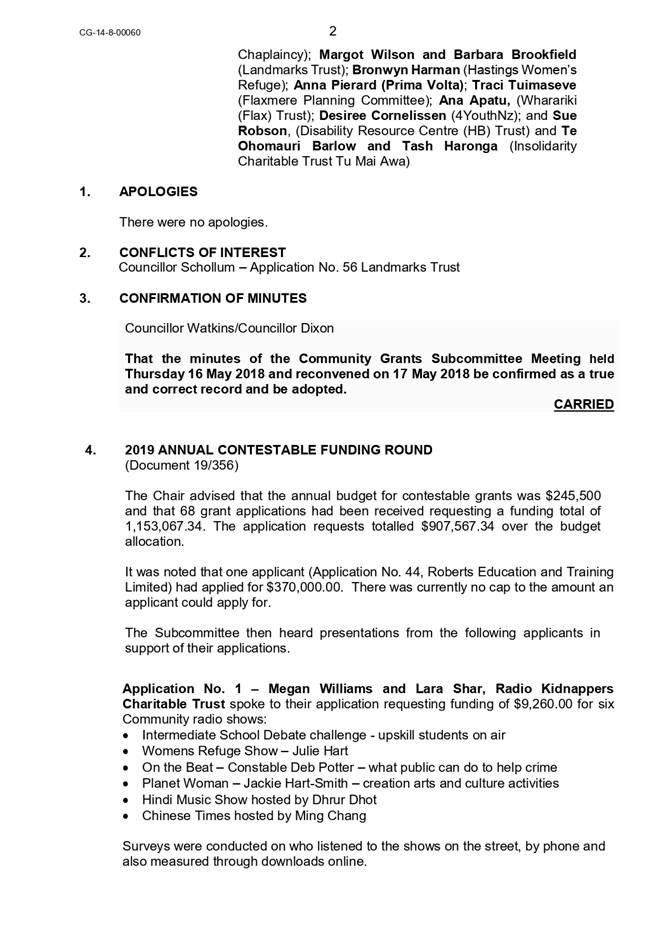

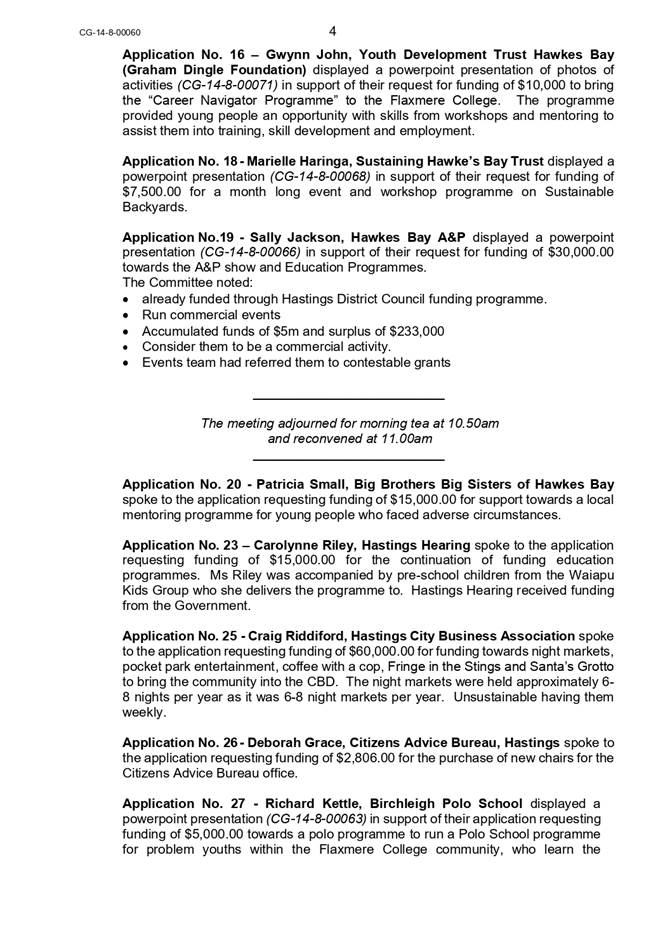





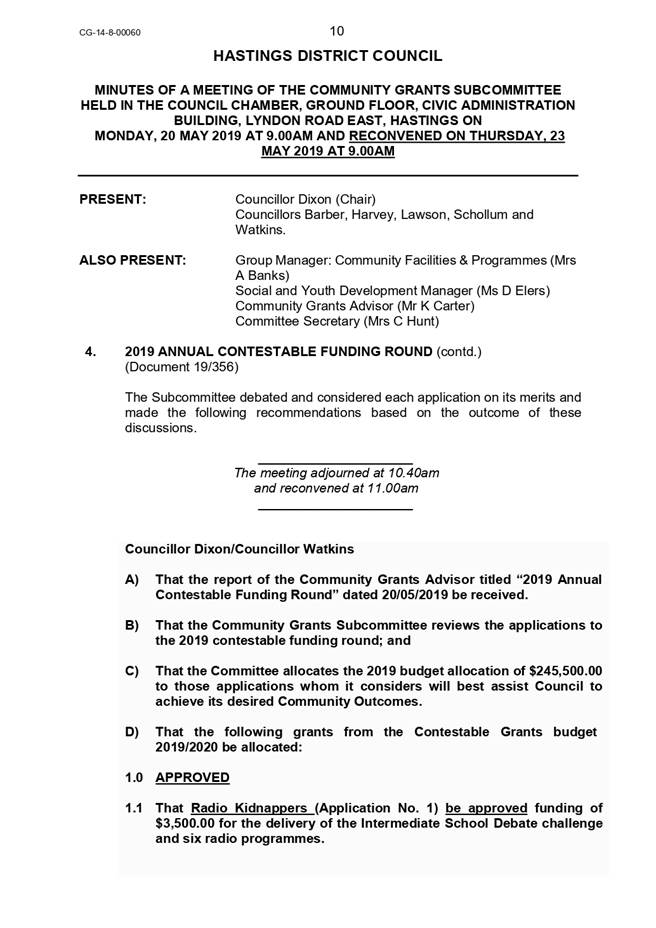
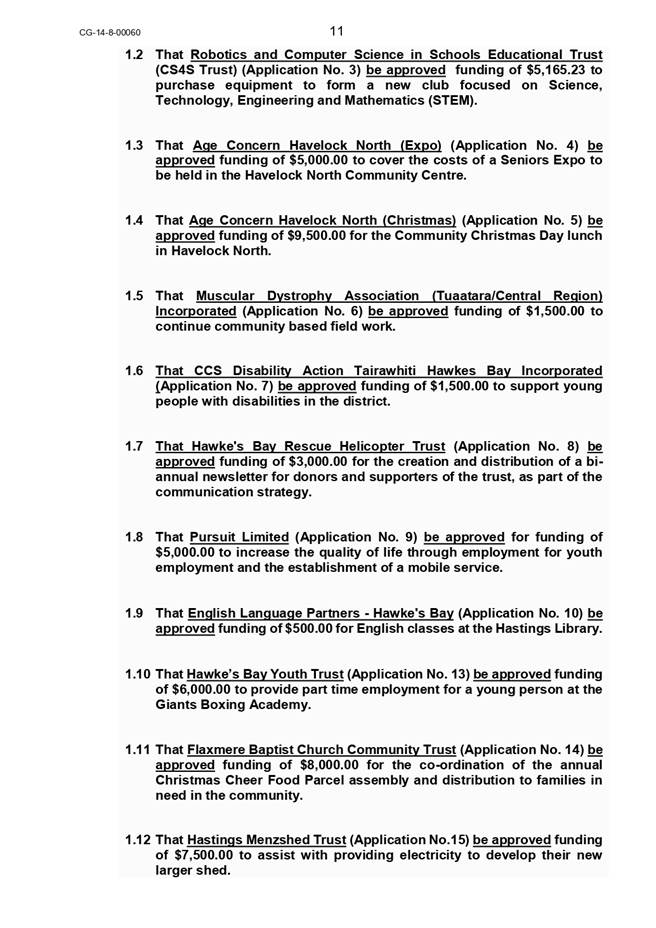
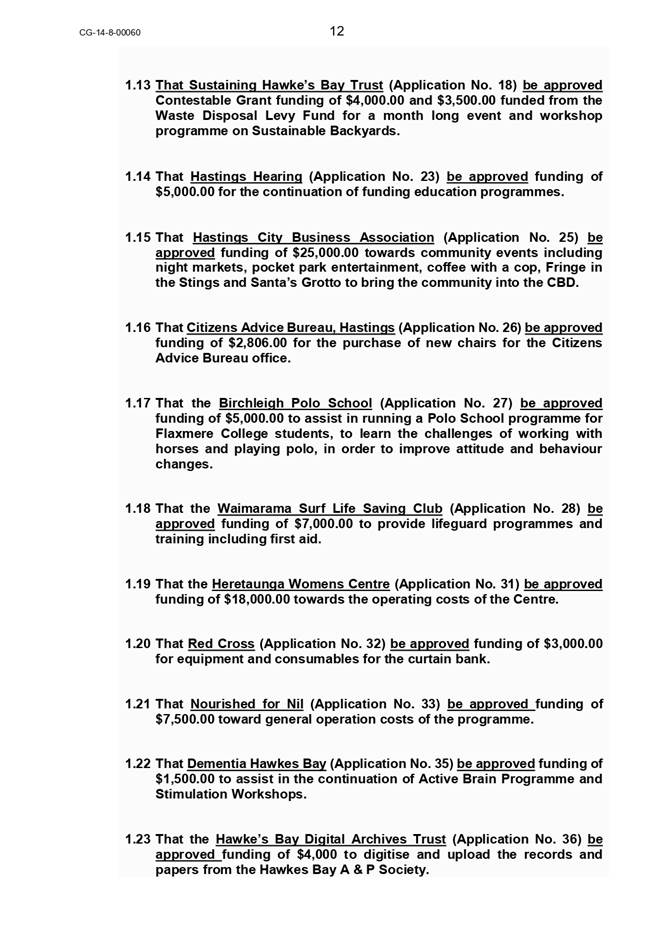

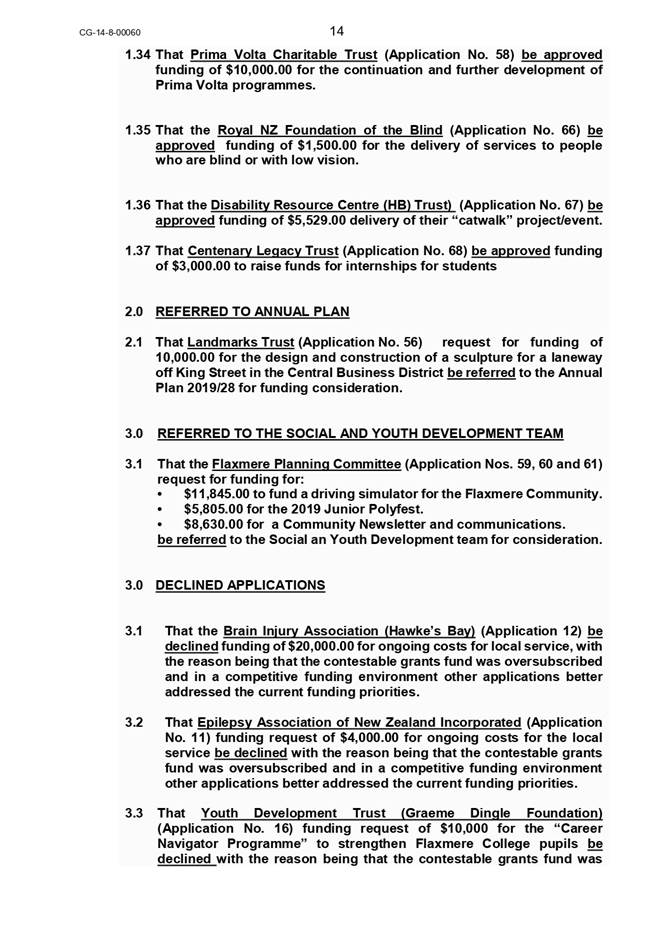
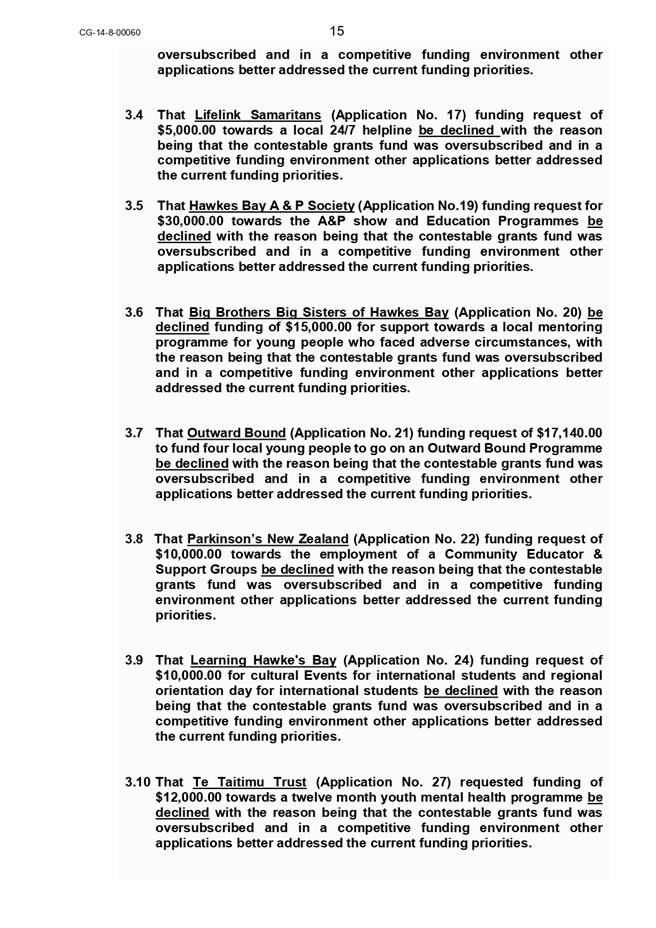

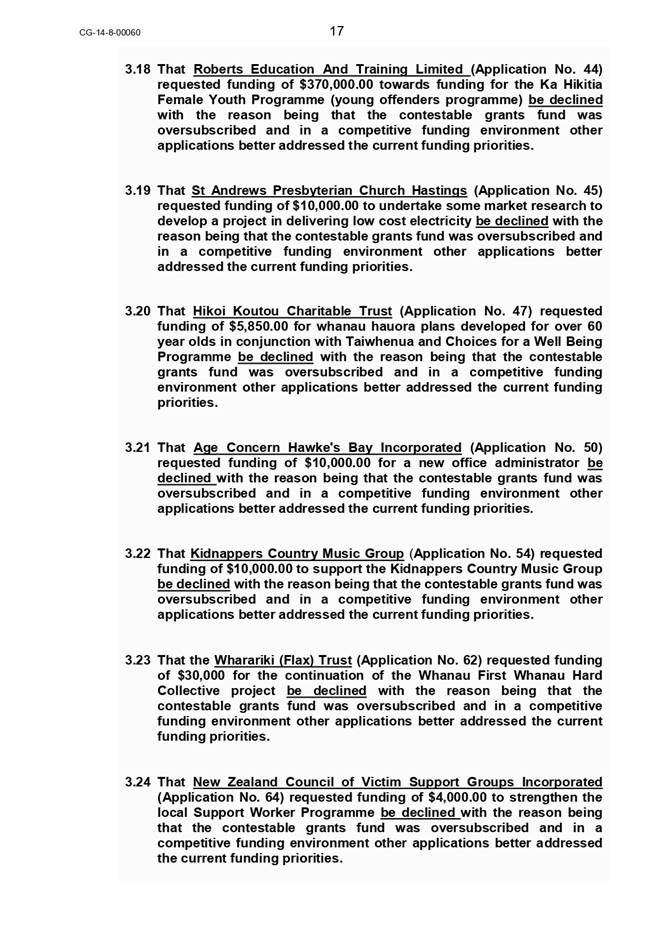
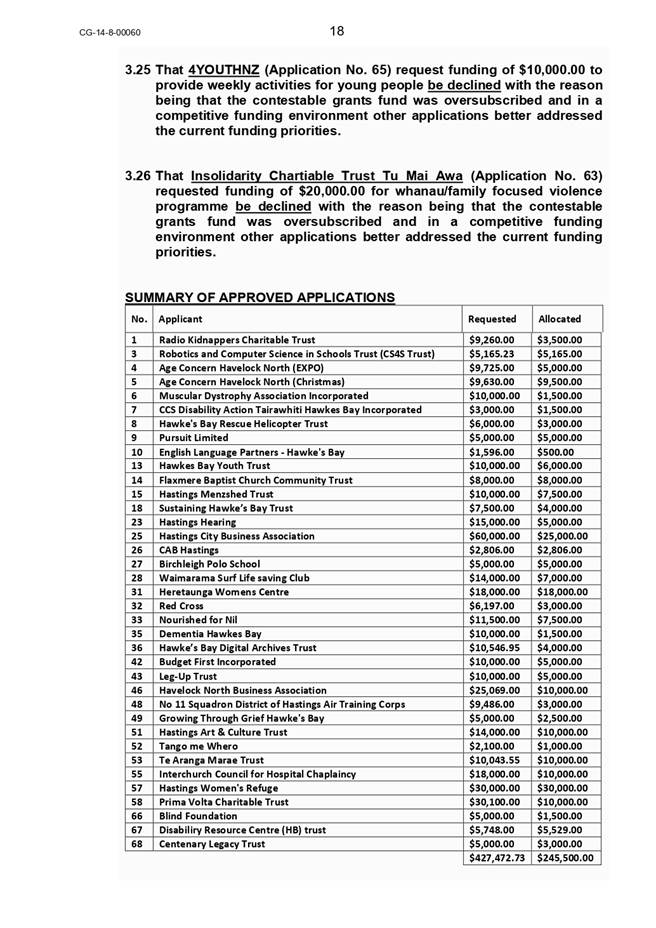
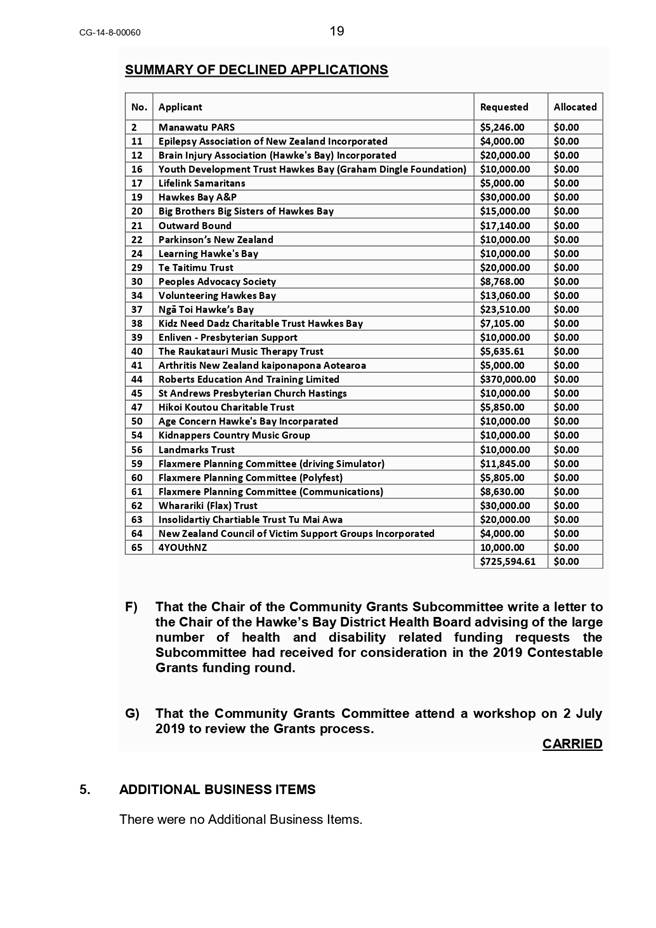

|
Community Grants Priorities for funding and Eligibility
Criteria
|
Attachment 2
|


REPORT TO: Council
MEETING DATE: Thursday 27
June 2019
FROM: Parks and Property Services Manager
Colin
Hosford
SUBJECT: Summary
of Recommendations from the Te Mata Park Trust Appointments Committee
1.0 SUMMARY
1.1 The
purpose of this report is to advise that recommendations from the Te Mata Park
Appointments Committee meeting held on 29 May 2019 require ratification by
Council.
2.0 BACKGROUND
2.1 The Te Mata Park Trust Board, at its meeting of 29 April 2019
discussed the issue of appointing three trustees as the term of the three
sitting trustees was to shortly to expire.
2.2 The Te Mata Park Trust Board recommended that Michael Bate, Ian Gold
and Mike Devonshire be reappointed as Trustees to the Te Mata Park Trust
Board.
2.3 The Board’s recommendation recognised their good service to
the park and is consistent with the both the Trust Deed rules, and Council’s
Policy of Appointments to the Te Mata Park Trust Board, that governs the
selection and appointment. This policy importantly, allows for trustees
to serve for up to nine years.
2.4 Accordingly the Appointments Committee considered the request from the
Te Mata Park Trust Board and endorsed the reappointment
of the three trustees.
3.0 RECOMMENDATIONS
3.1 The
recommendations of the Te Mata Park Appointments Committee to be ratified are
set out below.
|
4.0 RECOMMENDATIONS
AND REASONS
A. That
the report of the Parks and Property Services Manager titled “Summary
of Recommendations from the Te Mata Park Trust Appointments Committee ”
dated 27/06/2019 be received.
B. The following recommendations of the meeting held 29 May 2019 be
ratified:
“4. TERM OF APPOINTMENT FOR TRUSTEES
A) That
the report of the Parks and Property Services Manager titled
“Trustee Appointment Advertisement” dated 29 May 2019 be
received.
B) That the Te Mata Park Trust Appointments Committee
recommend to Council that the three vacancies not be advertised.
C) That the Te Mata Park
Trust Appointments Committee recommend to Council that the current trustee
appointments of Mike Devonshire, Michael Bate and Ian Gold be rolled over for
a further three years effective from 30 June 2019”.
|
Attachments:
There are no
attachments for this report.
REPORT TO: Council
MEETING DATE: Thursday 27
June 2019
FROM: Manager: Democracy and Governance
Services
Jackie
Evans
SUBJECT: General
Update Report and Status of Actions
1.0 SUMMARY
1.1 The
purpose of this report is to update the Committee on various matters including
actions raised at previous meetings.
1.2 The
Council is required to give effect to the purpose of local government as set
out in section 10 of the Local Government Act 2002. That purpose is to enable
democratic local decision-making and action by (and on behalf of) communities,
and to promote the social, economic, environmental, and cultural well-being of
communities in the present and for the future.
1.3 This
report concludes by recommending that the report titled “General Update
Report and Status of Actions” from the Manager Strategic Projects &
Partnerships be received.
2.0 BACKGROUND
2.1 Elected
members requested that officer’s report back at Council meetings with
progress that has been made on actions that may have arisen.
2.2 Attached
is a copy of Status Actions Attachment 1 including a copy of Crash Data (Attachment
2).
3.0 SIGNIFICANCE
AND ENGAGEMENT
3.1 This
report does not trigger Council’s Significance and Engagement Policy and
no consultation is required.
|
4.0 RECOMMENDATIONS
AND REASONS
That the report of the Manager: Democracy and Governance
Services titled “General Update Report and Status of Actions”
dated 27/06/2019 be received.
|
Attachments:
|
1
|
Status of Actions 27 June 2019
|
CG-14-1-01047
|
|
|
2
|
Crash Data
|
CG-14-1-01350
|
|
|
Status of Actions 27 June 2019
|
Attachment 1
|
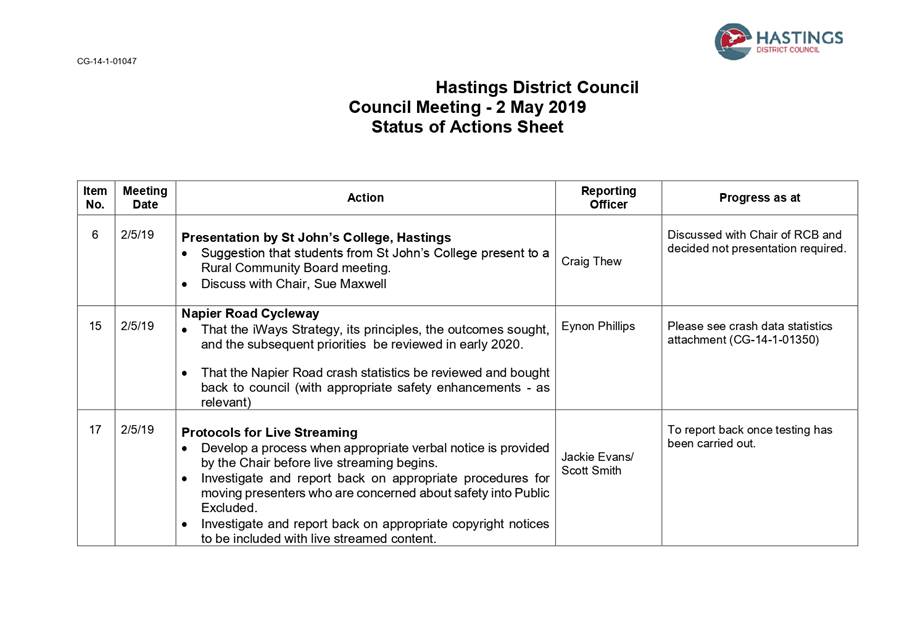
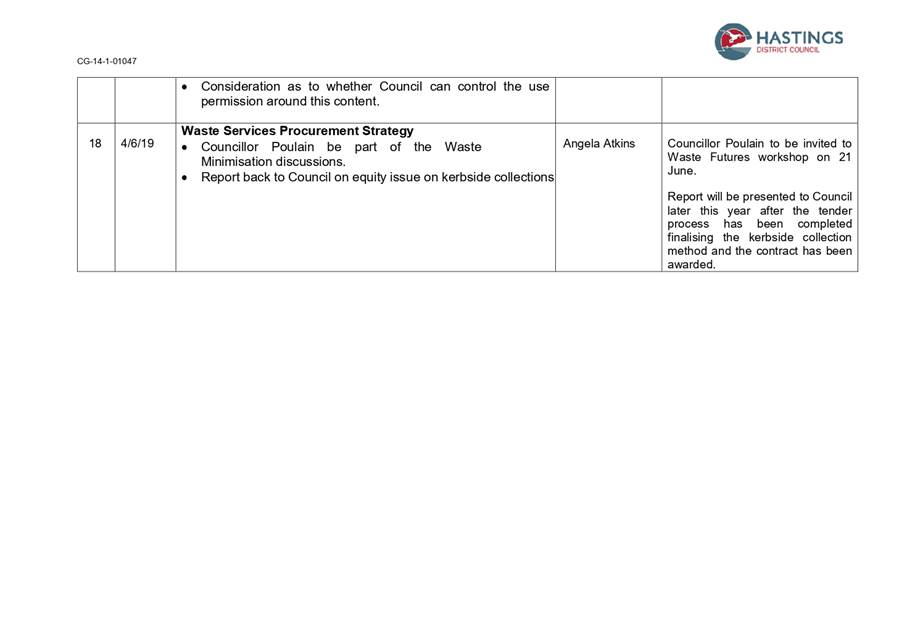
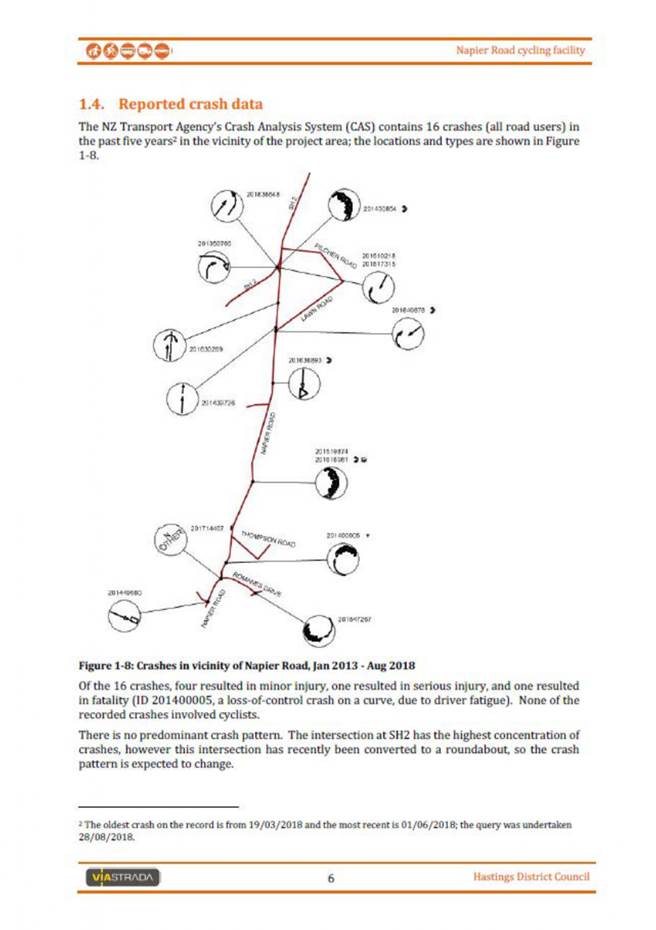
REPORT TO: Council
MEETING DATE: Thursday 27
June 2019
FROM: Manager: Democracy and Governance
Services
Jackie
Evans
SUBJECT: Requests
Received under the Local Government Official Information and Meetings Act
(LGOIMA) Monthly Update
1.0 SUMMARY
1.1 The
purpose of this report is to inform the Council of the number of requests under
the local Government official Information Act (LGOIMA) 1987 received in April
and May 2019.
1.2 This
issue arises from the provision of accurate reporting information to enable
effective governance
1.3 The
Council is required to give effect to the purpose of local government as
prescribed by Section 10 of the Local Government Act 2002. That purpose is to
meet the current and future needs of communities for good quality local
infrastructure, local public services, and performance of regulatory functions
in a way that is most cost–effective for households and businesses. Good
quality means infrastructure, services and performance that are efficient and
effective and appropriate to present and anticipated future circumstances.
1.4 The
objective of this decision relevant to the purpose of Local Government is to
ensure that the Council is meeting its legislative obligations.
1.5 This
report concludes by recommending that the report be noted.
2.0 BACKGROUND
2.1 The LGOIMA allows people to request official information held by
local government agencies. It contains rules for how such requests should be
handled, and provides a right to complain to the Ombudsman in certain
situations. The LGOIMA also has provisions governing the conduct of meetings.
Principle of
Availability
2.2 The
principle of availability underpins the whole of the LGOIMA. The Act explicitly
states that:
The question
whether any official information is to be made available … shall be
determined, except where this Act otherwise expressly requires, in accordance
with the purposes of this Act and the principle that the information shall
be made available unless there is good reason for withholding it.
Purpose of the
Act
2.3 The
key purposes of the LGOIMA are to:
· progressively
increase the availability of official information held by agencies, and promote
the open and public transaction of business at meetings, in order to:
o enable more
effective public participation in decision making; and
o promote the
accountability of members and officials; and
o so enhance respect
for the law and promote good local government; and
o protect official
information and the deliberations of local authorities to the extent consistent
with the public interest and the preservation of personal privacy.
2.4 City,
district and regional councils, council controlled organisations and community
boards are subject to LGOIMA and official information means any information
held by an agency subject to the LGOIMA.
2.5 It
is not limited to documentary material, and includes material held in any
format such as:
· written documents, reports, memoranda, letters, notes, emails and
draft documents;
· non-written documentary information, such as material stored on or
generated by computers, including databases, video or tape recordings;
· information which is known to an agency, but which has not yet been
recorded in writing or otherwise (including knowledge of a particular matter
held by an officer, employee or member of an agency in their official
capacity);
· documents and manuals which set out the policies, principles, rules
or guidelines for decision making by an agency;
· the reasons for any decisions that have been made about a person.
2.6 It
does not matter where the information originated, or where it is currently
located, as long as it is held by the agency. For example, the information
could have been created by a third party and sent to the agency. The
information could be held in the memory of an employee of the agency.
What does a
LGOIMA request look like?
2.7 There
is no set way in which a request must be made. A LGOIMA request is made in any
case when a person asks an agency for access to specified official information.
In particular:
· a request can be made in any form and communicated by any means,
including orally;
· the requester does not need to refer to the LGOIMA; and
· the request can be made to any person in the agency.
2.8 The
Council deals with in excess of 14,000 service requests on average each month
from written requests, telephone calls and face to face contact. The LGOIMA
requests dealt with in this report are specific requests for information logged
under formal LGOIMA procedure, which sometimes require collation of information
from different sources and/or an assessment about the release of the
information requested.
Key Timeframes
2.9 An
agency must make a decision and communicate it to the requester ‘as soon
as reasonably practicable’ and no later than 20 working days after
the day on which the request was received.
2.10 The
agency’s primary legal obligation is to notify the requester of the
decision on the request ‘as soon as reasonably practicable’ and
without undue delay. The reference to 20 working days is not the de facto goal
but the maximum unless it is extended appropriately in accordance with the Act.
Failure to comply with time limit may be the subject of a complaint to the
ombudsman.
2.11 The
Act provides for timeframes and extensions as there is a recognition that
organisations have their own work programmes and that official information
requests should not unduly interfere with that programme.
3.0 CURRENT
SITUATION
3.1 Council
has requested that official information requests be notified via a monthly
report.
|
4.0 RECOMMENDATIONS
AND REASONS
A) That
the report of the Democratic Support Manager titled “Requests
Received under the Local Government Official Information and Meetings Act
(LGOIMA) Monthly Update” dated 27/06/2019 be
received.
B) That the LGOIMA requests received in April and May 2019 as set out
in Attachment 1 (IRB-2-01-19-1591) of the report in (A) above be noted.
|
Attachments:
|
1
|
Information Mgmt & Reporting - Information
Requests - LGOIMA - Monthly Report to Council - April and May 2019 - Council
27/6/19
|
IRB-2-01-19-1591
|
|
|
Information Mgmt & Reporting -
Information Requests - LGOIMA - Monthly Report to Council - April and May
2019 - Council 27/6/19
|
Attachment 1
|
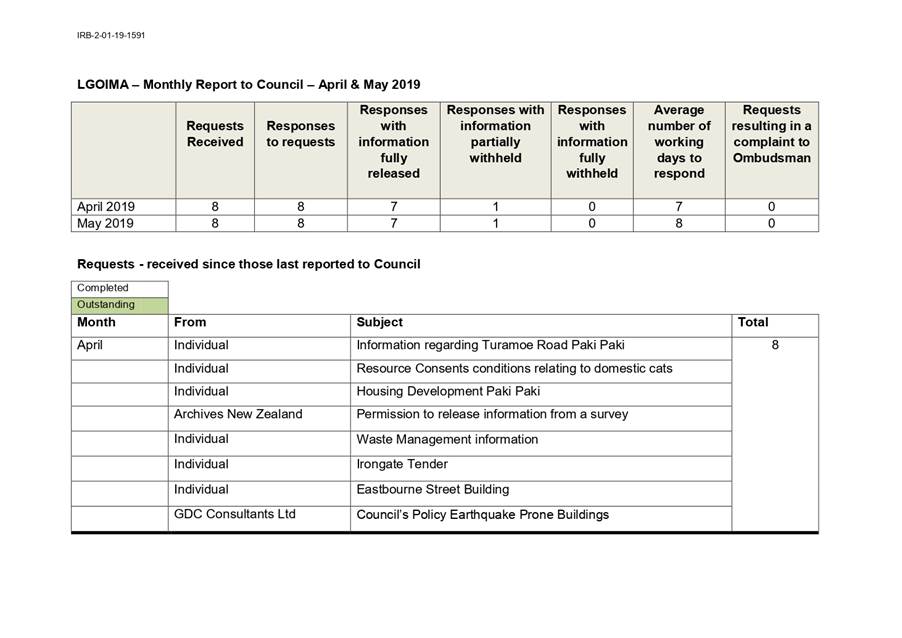
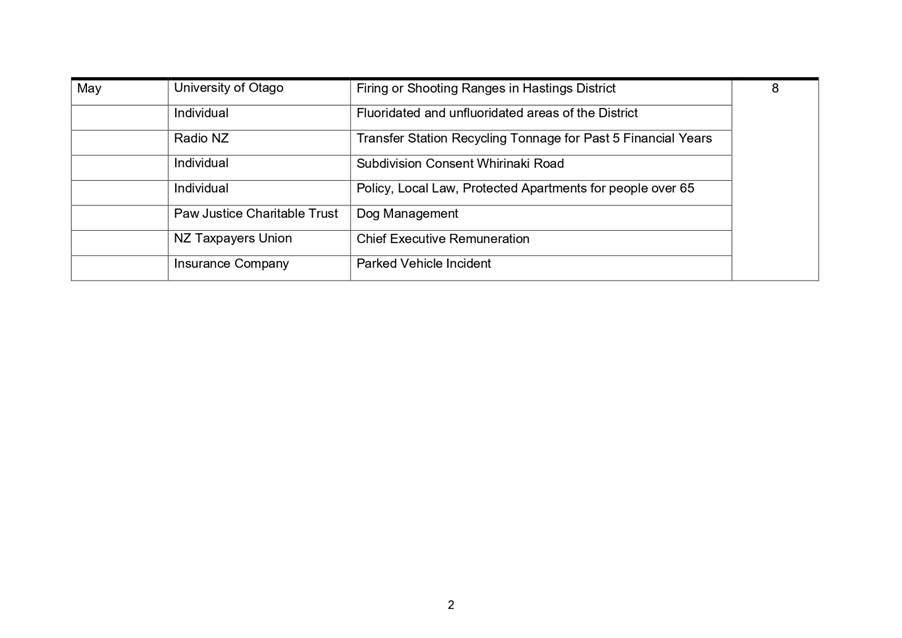
REPORT TO: Council
MEETING DATE: Thursday 27
June 2019
FROM: Manager: Democracy and Governance
Services
Jackie
Evans
SUBJECT: Updated
2019 Meeting Schedule Changes
1.0 SUMMARY
1.1 The
purpose of this report is to consider amendments to the schedule of Council and
Committee Meetings for the 2019 Meeting Calendar which was adopted by Council
on 6 December 2018.
1.2 This
report recommends that the 2019 Meeting Schedule as amended below be adopted.
2.0 BACKGROUND
2.1 The
Local Government Act 2002, Schedule 7, Clause 19 states:
(4) A local authority must hold
meetings at the times and places that it appoints”.
(5) If a local authority adopts
a schedule of meetings-
a) The
schedule-
i) may cover any future period
that the local authority considers appropriate, and
ii) may
be amended
2.2 Although
a local authority must hold the ordinary meetings appointed, it is competent
for the authority at a meeting to amend the schedule of dates, times and number
of meetings to enable the business of the Council to be managed in an effective
way.
2.3 The
following meetings are proposed to be included or amended in the 2019 meeting
schedule:
|
Committee
|
Date
|
Time
Prev
1pm
|
Venue
|
|
Council
|
11
July 2019
|
10.30am
|
Waipatu
Marae/Council Chamber
|
|
Council
|
22
August 2019
|
10.30am
|
Council
Chamber
|
|
Council
|
26
September 2019
|
10.30am
|
Council
Chamber
|
|
Council
|
10
October 2019
|
10.30am
|
Council
Chamber
|
2.4 Councillors will be kept informed
of specific changes on a day to day basis through the centralised calendar
system.
|
3.0 RECOMMENDATIONS
AND REASONS
A) That
the report of the Manager: Democracy and Governance Services titled “Updated
2019 Meeting Schedule Changes” dated 27/06/2019 be
received.
B) That the 2019 Meeting Schedule be amended as follows:-
|
Committee
|
Date
|
Time
(Prev 1pm)
|
Venue
|
|
Council
|
11
July 2019
|
10.30am
|
Waipatu
Marae/Council Chamber
|
|
Council
|
22
August 2019
|
10.30am
|
Council
Chamber
|
|
Council
|
26
September 2019
|
10.30am
|
Council
Chamber
|
|
Council
|
10
October 2019
|
10.30am
|
Council
Chamber
|
|
Attachments:
There are no
attachments for this report.
|
TRIM File No. CG-14-1-01352
|
HASTINGS DISTRICT COUNCIL
Council MEETING
Thursday, 27 June 2019
RECOMMENDATION TO EXCLUDE THE PUBLIC
SECTION 48, LOCAL GOVERNMENT OFFICIAL INFORMATION AND
MEETINGS ACT 1987
THAT the public now be excluded from the
following part of the meeting, namely:
23. Summary
of Recommendations of the Appointments Committee meeting held 18 June 2019
24. Howard
Street Urban Residential Zone
25. Land
Acquisitions for Irongate Road Roundabout
26. Land
Acquisitions for Omahu/Henderson Roundabout
27. Hawkes
Bay Opera House Arts and Events Precinct Update
The general subject of the matter to be
considered while the public is excluded, the reason for passing this Resolution
in relation to the matter and the specific grounds under Section 48 (1) of the
Local Government Official Information and Meetings Act 1987 for the passing of
this Resolution is as follows:
|
GENERAL SUBJECT OF EACH MATTER TO BE CONSIDERED
|
REASON FOR PASSING THIS RESOLUTION IN RELATION TO
EACH MATTER, AND
PARTICULAR INTERESTS PROTECTED
|
GROUND(S) UNDER SECTION 48(1) FOR THE PASSING OF EACH
RESOLUTION
|
|
|
|
|
|
23. Summary
of Recommendations of the Appointments Committee meeting held 18 June 2019
|
As stated in the minutes
|
Section
48(1)(a)(i)
Where the Local
Authority is named or specified in the First Schedule to this Act under
Section 6 or 7 (except Section 7(2)(f)(i)) of this Act.
|
|
24. Howard
Street Urban Residential Zone
|
Section 7 (2)
(i)
The withholding
of the information is necessary to enable the local authority to carry on,
without prejudice or disadvantage, negotiations (including commercial and
industrial negotiations).
Protect potential
land acquisition negotiations.
|
Section
48(1)(a)(i)
Where the Local
Authority is named or specified in the First Schedule to this Act under
Section 6 or 7 (except Section 7(2)(f)(i)) of this Act.
|
|
25. Land
Acquisitions for Irongate Road Roundabout
|
Section 7 (2)
(i)
The withholding
of the information is necessary to enable the local authority to carry on,
without prejudice or disadvantage, negotiations (including commercial and
industrial negotiations).
To enable Council
to undertake negotiations.
|
Section
48(1)(a)(i)
Where the Local
Authority is named or specified in the First Schedule to this Act under
Section 6 or 7 (except Section 7(2)(f)(i)) of this Act.
|
|
26. Land
Acquisitions for Omahu/Henderson Roundabout
|
Section 7 (2)
(i)
The withholding
of the information is necessary to enable the local authority to carry on,
without prejudice or disadvantage, negotiations (including commercial and
industrial negotiations).
To enable Council
to undertake negotiations.
|
Section
48(1)(a)(i)
Where the Local
Authority is named or specified in the First Schedule to this Act under
Section 6 or 7 (except Section 7(2)(f)(i)) of this Act.
|
|
27. Hawkes
Bay Opera House Arts and Events Precinct Update
|
Section 7 (2)
(h)
The withholding
of the information is necessary to enable the local authority to carry out,
without prejudice or disadvantage, commercial activities.
To protect the
commercial sensitivities until a new name is secured.
|
Section
48(1)(a)(i)
Where the Local
Authority is named or specified in the First Schedule to this Act under
Section 6 or 7 (except Section 7(2)(f)(i)) of this Act.
|
 Hastings District
Council
Hastings District
Council














































































